-
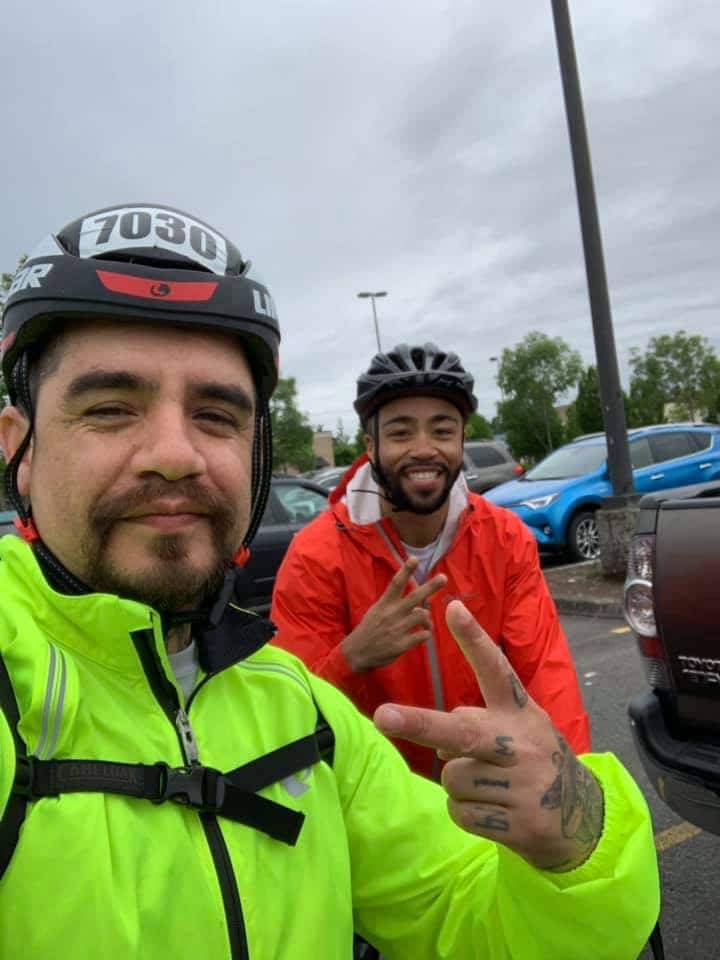
From Seattle To Portland, Riding For Recovery
“The Ability to Feel Again is My Greatest Reward”
The mountains have been one of several healers for Jose, who, by the grace of God, will be sober for 11 years on August 29, 2019. Sitting across the table from him at the XXX Diner in Issaquah, he sits with a warm smile on his face, his heart on his sleeve, and shares his story of addiction, recovery, God, his mother, and how he found Recovery Beyond.
Journey into Drugs and Alcohol
The path to drugs and alcohol was easily accessible to Jose at a young age. They provided an escape from reality and pain. He began drinking and got drunk for the first time when he was just eleven years old. That summer in Oregon, where he was born and raised, was a blur. Marijuana followed and so did the trouble. By the time Jose turned seventeen, he had three felonies, with charges ranging from minor in possession to felony gun possession and everything in between. He candidly describes the time there was a gang shoot-out down the street from him. Bullets whizzing by his head, left and right, he grabbed his niece who was playing outside in the front yard and threw her back into the house to save her.
Jose knew he was a rough kid. No person, child or adult, should ever have to endure the types of abuse, violence, poverty, and hard situations he saw and experienced. His mom did all she could to protect and provide for her children and get them involved in programs at the YWCA, but kids often have other agendas. His Grandma was a CPS director for many years and helped when she could through programs she had access to. Jose remembers food bank lines, Christmas baskets, and programs at churches. He remembers finding his mom in her bedroom closet crying because she couldn’t afford Christmas presents that year. He told her it was ok and not to worry. He remembers holding her as she wept.
Cocaine was the next drug to come along. He was introduced to it when he was 19, and initially used it to make money. It eventually became the mechanism he needed for his own use. He and other individuals would rob drug dealers at gunpoint to steal their drugs. Crack cocaine…crystal meth. They would take the cocaine and make crack to resell. The purer the cocaine they could get, the better the crack, and the more customers they would have. It was a good business plan for the situation they were in, and along with this plan came the parties, the girls, and the hotels. Money went fast. Real fast. By the time he was introduced to heroin, he realized he had stepped into territory from which he may never return.
He knew he needed to stop.
He made several attempts to stop using and get help. He graduated from Lakeside-Milam treatment ten years ago, started attending church, and ultimately got full custody of his four children, whom he shared with a woman who ran with him and his drug use.
He has been together with his current wife for nine years. He met her after he had been clean for two years, so she doesn’t know him in his addiction. He knows himself, though, and knows the warning signs and has warned her about them. He knows if he starts using again that he will run through her emotions and mental state like a hurricane and won’t think twice about it.
Jose will look you straight in the eye and tell you that he is blessed to be alive.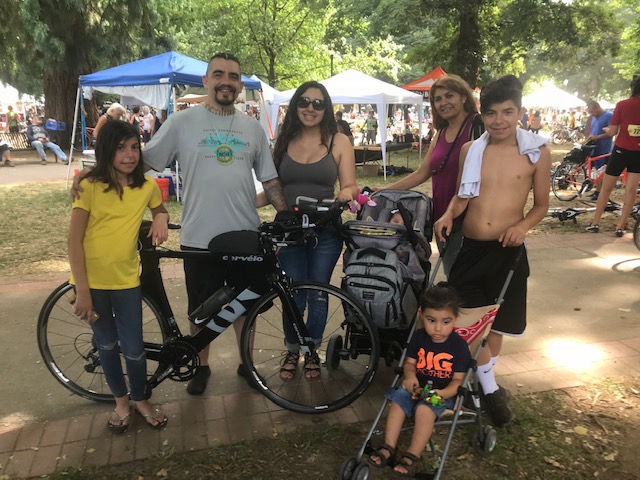
A Mom Who Did It All
“Leave your surfboards at home. Allow the waves to wash over you. Allow the grief to overtake you. If you know how to ride it correctly, you’ll ride it smoothly down. If not, you’ll fall off and that’s ok. When you allow those waves to take you and toss you around, you can look at them and say, ‘I survived this one, I can survive the next one.’ They build you.”
Two years ago, Jose abruptly and tragically lost his mother. A single mother, she did it all. She raised five children, was the pillar of her family, and at the time of her sudden and unexpected death, was three months sober and so proud of it.
After her death, Jose remembers looking up at the sky, begging for God to slow down. He didn’t call his sponsor. He didn’t hike. He did nothing. Jose was on a mission to get loaded, so he turned his phone off, got dressed, and left. The last thing he wanted to do was feel. His wife asked where he was going, and he said, “I’ll be back.”
Jose went to a bar.
The bartender greeted him saying, “Hey sweetie, how’s it going?” He ordered three double shots of tequila and scooted up close to the bar. Inhaling deeply, he picked up one of the shots, held it to his nose, smelled it, and then put it down.
His hands shook.
He looked to the sky.
The bartender walked by looking at him oddly. Jose hadn’t taken the shots yet and was aware that he was being watched. He asked for a Coca Cola to chase the tequila down as if to buy him time. After he realized what he was doing, a wave came over him and the tears started.
The bartender walked by, again, looked at him, and saw that he was crying. Really crying. Jose was trying to hold the tears in. Sniffling, he put his hand on his hip, and his finger felt something in his fifth pocket. He fiddled around and pulled the object out.
It was his three-year coin.He can’t begin to tell you why that coin was there that day. Maybe he wore those pants to a meeting. But of all the pants to wear that day, of all the objects that could be in the pocket of the pants worn on that day, this was the one that was there. And it was just what he needed.
He pulled it out of his pocket and cried. He slammed the coin on the table with affirmation.
That bartender turned right around and looked. She saw the coin, looked at his tearful face, grabbed his drinks, pulled them away and said, “Sir, I need you to leave right now. You need to get out of here, honey.”
Jose grabbed the coin and stuck it in his pocket, reached into his other pocket for his wallet to pay, which the bartender refused to accept.
“You better get the hell out of here and never come back,” she said. Jose apologized for wasting the tequila and she looked at him and said, “Just GO.”
This is the one time that he felt closest to a relapse.
What did he do next? In order to counter the feelings he was having over the death of his mother, he took on a lot of extra activities to counterbalance his emotions. He didn’t want to feel but had to fight this thing within him, his addiction, with everything he had. If he went back to using, he would be useless to everyone. He knew he would pick up right where he left off.
So he started biking. Hiking. Doing Hot Yoga and Brazilian Jiu-Jitsu. Picture this: an ex-gang member, in and out of jail, covered from head to toe in tattoos, who grew up in rough neighborhoods, can now be found doing hot yoga, breathing, wearing yoga pants and a tank top, running, and exercising.Jose did every physical activity he could get his hands on. It was difficult for others to understand the magnitude of what was going on inside him. A lot of people said, “Slow down.”
These were his healers, however. Biking, hiking, jiu-jitsu, hot yoga, and, of course, God. These things propelled Jose into the activities he does now.
A few months ago, Jose was at work and walked past the opening of a garage, not even thinking of his mom. A breeze blew through sending along with it the smell of his mom’s perfume, a perfume she had received every Christmas as a gift from Jose. Jose said, “Mom?” and turned to look for her. He saw a woman, who was not his mother, standing by the garage opening. She must’ve been wearing that perfume. It was heartbreaking and crushing for him. As much as he didn’t want to feel the things he was feeling at that moment, he had to ride that wave. Because he has learned how to manage his feelings, he knows how to let the waves of emotions come and go.
Church, The Mountains, and Community
Church also changed for him. He remembers ten years ago leaving everything on the floor for God. Jose said, “God, take it all, strip me down to the bones, rewire me into the person I’m meant to be when I came down to this Earth.”
At an altar he recalls someone putting a hand on his shoulder, and then another hand on his other shoulder. He didn’t know who it was but knew someone was there with him. He remembers turning around after an ocean of tears, a spiritual cleansing, if you will, and seeing thirty to forty people with their hands on each other’s shoulders in prayer over him. There was this whole, powerful community, and it was amazing.
Community is so important.
Jose served in the children’s ministry, as an usher, at the welcome center, in the group for those with alcoholism and addiction, and in forgiveness classes for men ages 12-60. But after his mom’s funeral service, it was too painful for him to return. So he found church elsewhere, but this time without four walls and this time in a more intimate way with God.
For a few years, Jose had been solo hiking. He had been yearning, praying, and asking for God to meet him in some way, in some form, and God has been doing just that. Jose has been and still is drawn to the mountains and believes that God calls him where he wants to be. That’s where he goes and stays faithful. Ten out of ten times, God is right. Even though church has been very important to Jose in the past, he believes that God is now leading him into the classroom of silence; that he must enter alone to understand himself better. Yes, God is always right in that space, even if Jose doesn’t understand it right away.
On a hike to High Rock lookout, Jose went in as an emotional wreck. Once he got to the lookout and went inside, he noticed something etched into one of the walls. It said, “Greater is he who the mountains bow before”.
He felt chills. He felt like God was there with him. Without a doubt, he knew He was there.
On another hike to Thunder Lake, Jose separated from friends and was walking alone. There were beautiful wildflowers in bloom everywhere. “Touch of Heaven” by Hillsong had just played on his music playlist. He was missing his mom. All of a sudden, the clouds broke open. Jose was so overcome with emotion that he fell to his knees and let God’s spirit wash over him.
An army of butterflies propelled out of the surrounding landscape, hit, and bounced off of Jose and then flew away.
He was crying. “Ugly, baby face crying” as he so eloquently put it. He got up and passed another hiker who asked if he was alright and Jose said, “I’ve never been better.”
“I had done Mailbox earlier this year, sunset hike, 3 AM. I swear there were cougars out, so I had a machete and gun, every couple of steps stopping, did you hear that? I got up there, saw the sunrise, and it was beautiful. That was a moment between me and God. That’s my church up there. It’s very real, very raw. Me and God are on another level. God wants me in my purest form, broken, raw, alone, teachable, open. He wants the nitty gritty, he wants to do a spiritual gardening in me, yanking out weeds, in purgatory, being purged of all these things…”
Community. Jose was looking for a community of sober hikers and ways to help people in recovery when he stumbled across a post about Recovery Beyond by McKenzie Johnson on a popular Facebook hiking and climbing page called the Washington Hikers and Climbers. He reached out to McKenzie, was connected with Nate, Recovery Beyond Program Manager, and everything snowballed from there. Jose wanted to share what he’s been given with other people, and now he had the opportunity.
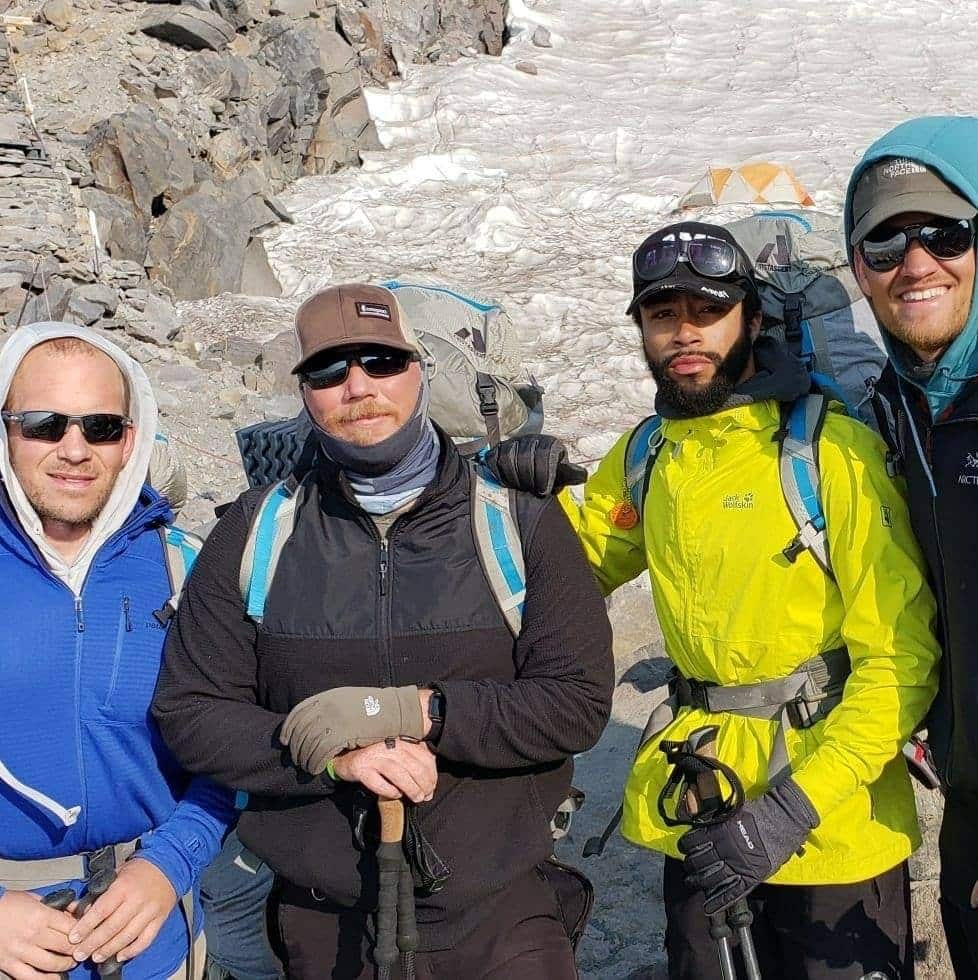
His first hike with Recovery Beyond was Mailbox Peak. He gravitated toward a participant named Jason who was newer in his recovery and they hiked together and shared stories. He admits that he walked into this hike with a bit of ego, but toward the end of the hike, he found himself changed and inspired by those he hiked with. He was humbled by this experience.
Conviction
“In my recovery, there isn’t one thing that I haven’t asked for that God hasn’t given me. It happens In His own time though.”
Tattooed across Jose’s knuckles is a gentle reminder to “Sink or Swim”, a simple and perfect metaphor to live by.
At times, Jose admits he’s guilty of wanting to force things, manipulate things, and control things. We all do this and then we are confused as to why things don’t work out the way we want them to. It’s not until later that we may understand why things had to happen a certain way. Jose states that God has a really funny sense of humor and that if you want to make God laugh, tell him your plans. You have to let things go and let God take control, and that’s hard, Jose says. He wonders, how do I get to where God is calling me?
He tells people in recovery that he understands the disease part. It’s in his genetics – his mom, uncles, and cousins all have addictions. He states, “I can only speak for myself. The disease is there…I have a choice, though. (He motions to the glass of water in front of him) If I choose to pick up that glass of water, put it to my mouth – that’s a choice. The moment the water enters my mouth, that’s where the disease kicks in.” And that’s where he sees the difference between choice and disease.
Addiction is a medical, psychological, social, and individual issue. It’s not easily fixable. People need people because we are social creatures and we need positive reinforcement. No one teaches us that, so it must be learned. Those with addiction are very emotional people. If they’re ready for help at 12:57 and no one shows up till 1:00, then they’re already using. By creating community, you put a person in a place where that window of opportunity is now just a little bit bigger.
Mirror in the Jungle
“So we’re doing this hike up to Mailbox… and Tyler or Jason, one of the two, said, hey man, have you ever seen the video of the dude who goes up in the jungle and puts his mirror up with a video camera and lets it run so the animals see it and react?”
Jose thought about this and then it hit him. “Wait a minute you guys”, he said, “listen to what you just said! That’s us. We’re the animal out in the wild! Imagine living your entire life never looking at yourself in the mirror. We’re out here looking at ourselves for the very first time. For 17 years I was using and never looked in a spiritual mirror. When someone gave me a mirror, I saw who I really was, who I had become, and I didn’t like it. I was confused – I didn’t use to be this person.”
“That’s why I like going out to the mountains – there’s no Facebook, wife, kids, work… it’s just me and God. In His creation, sometimes I get so overwhelmed emotionally. You see these landscapes, the beauty in them, and it’s just like, wow- how? All he did was just *poof*. And then you think to yourself, what else is out there? This is just a teeny tiny sliver of what’s out there. What’s in Colorado or the other side of the world? Makes you start thinking. It’s inspiring – I want to go see these things. We are only here for a short time…We have a bag full of excuses. At what point do we take that bag and toss it aside and actually go out and live?”
Spiritual Hole
“Shake me as much as you can, [God], I’m not going to fight you.”
It wasn’t until 3 years into his recovery that something occurred to Jose that was mind-blowing. The best thing he had given himself in his sobriety was the ability to feel. Feeling was the one thing he tried to escape for seventeen years. He was finally able to feel all emotions, the good and the bad, to feel them honestly, with nothing in between, unfiltered, uncensored, and in their rawest and purest form. He has had to embrace those feelings because that’s where the healing comes from.
Why would you want to mask that?
Life isn’t good all the time, and we may ask why, why right now? But the ability to feel, the excitement, the joy, the happiness, the euphoric joy, and the darkest times, is something Jose states he would not trade for anything. When he thinks about relapse, he thinks about how he wouldn’t be able to feel anymore. He knows how to manage his feelings now. Managing feelings can be taught. If you get the tools to work your way through it, then you can use those skills over and over. Again, choices.
“There’s nothing that anyone could’ve told me when I was using that would’ve changed my mind to get sober. There’s nothing that anyone can tell me in my recovery that would convince me to start using again. It’s in the person. You can work and try and lead a horse to water, but if the person isn’t willing to do so then it won’t work for them. This is why people have to go through recovery seven times.”
Being in the mountains, on the mat, out on the trails on his bike, all of these things help him to prioritize everything in his life.
STP Ride: Seattle to Portland, 206 Miles, July 13-14, 2019
Building Healthy Lifestyles for Lasting RecoveryThis is Jose’s third year participating in STP. The ride has become his annual emotional retreat. He first started this race the year his mom passed away. This year, Jose is doing the race for his mom.
He got his first bike at work: he found a bike that had been locked to a place where it shouldn’t have been locked. The manager said to clip it and get rid of it. Jose asked if he could take the bike, the manager said ok, and Jose started riding. A month later, he found out about the STP ride and entered himself to participate. He went 115 out of 206 miles but had to call it quits. Despite his mental fortitude, his legs and knees refused to do any more. He called his wife and she came and picked him up.

Even though he hardly trained for this ride, he was disappointed that he didn’t make it the whole way. The lesson? You must go through a season of preparation, as with all things in life, a lesson that Jose learned on this first ride.
The next year, he joined up with the Cascade Bicycle Club and started to train. They provided a great wealth of information for him. He also found other bikers to ride with and they committed to each other to do the STP ride. Along the ride, Jose encountered many riders who were also in recovery. On his second year of participating in this race, they made it the whole way to Portland.
Jason, who is new in recovery, who met Jose on Mailbox Peak, expressed interest in riding. They have been training together and are looking forward to the upcoming STP ride.
It’s amazing what happens when connections are made and community is created. It’s amazing how one life changes for the better and can influence and support the change in another life. Being able to support others in recovery in something Jose wants to do and now has the opportunity. He is thankful to have found the community he needed in Recovery Beyond.
Please consider a gift to Jose or Jason’s fundraising page for the STP race. All funds will go toward supporting program participants and expanding programming for Recovery Beyond. We thank you for supporting our organization and our growing community. We couldn’t do what we do without you.
DONATE TO JOSE’S CAMPAIGN DONATE TO JASON’S CAMPAIGN2 -
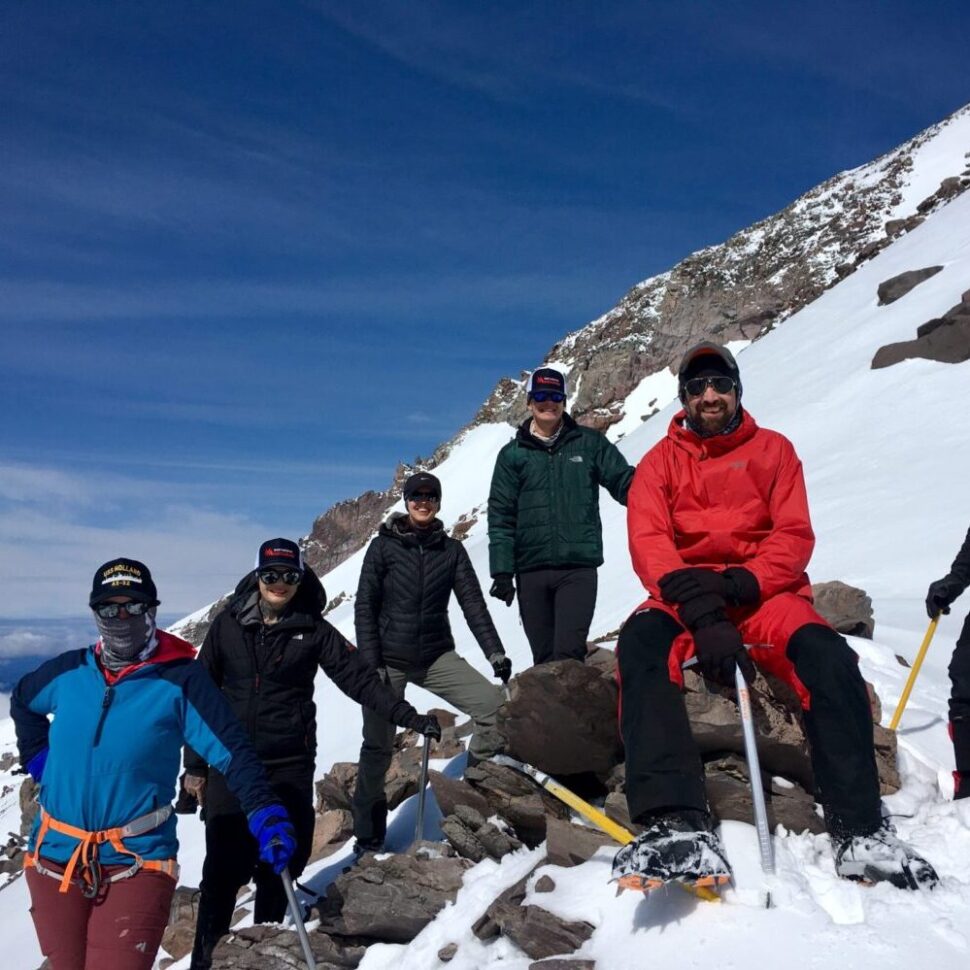
Braving The Elements To Support Lasting Recovery
“Usually, when I tell someone I climb mountains with “former addicts”, I get a response along the lines of, ‘That’s so cool! If you can climb a mountain, you can do anything, right?!’ Well, yes… and no. Reaching the summit of a big peak is incredible. For most of our recovery climbers, it’s something they would never have a chance to do outside this program. But if you ask any of these men or women what the true benefit is, they’ll tell you it’s about the team. […] It is my deep honor to journey with them as they continue to climb the greatest mountain of their lives – overcoming what led them to addiction and choosing to pursue healthy relationships and a life of sobriety. They are truly my heroes.” – Amelia, Fundraising climber
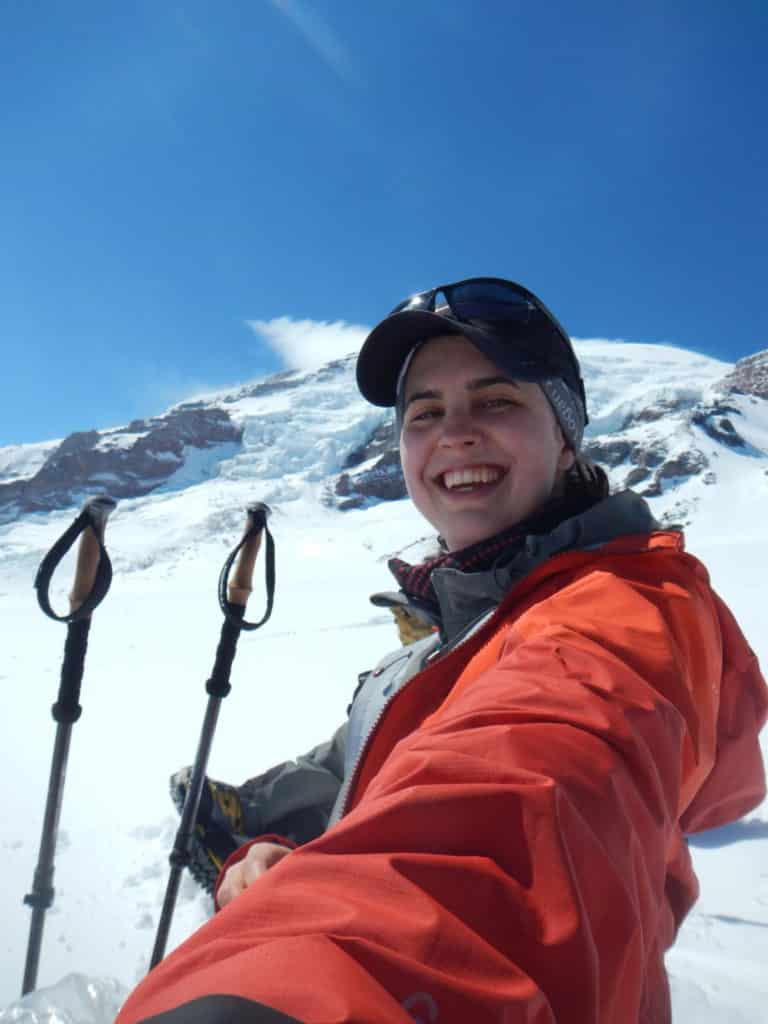
- Photo Courtesy Amelia Kaiser
Amelia is just one of seven fundraising climbers that participated in the Mount Rainier Fundraising climb this year. From May 16 -19, 2019, seven of our climbers, Abi Brewer, Camiya Brown, Christopher Poulos, Nate Lanting, Scott Brown, Amelia Kaiser, and Becky Vinson embarked on a climb of 14,411’ Mount Rainier to fundraise for Recovery Beyond. To date, gifts from 133 donors have been received and funds will go toward supporting our recovery program participants and expanding our programs.
We are blown away by this support and are filled to the brim with gratitude.
Though the climb itself is over, you can still contribute to our individual climber’s fundraising pages. Every fundraising climber has a reason for participating. Fundraising climber Christopher Poulos states, “The outdoors remains an essential component to my recovery and has helped me find both peace and community.”
While you graciously consider a donation that will reshape a life, let us give you a glimpse into the type of community we are building and the supportive network we have by sharing details of this fundraising climb.
For our climbers, it wasn’t about the summit. It was about the journey, raising awareness for addiction recovery, and creating a sober community.
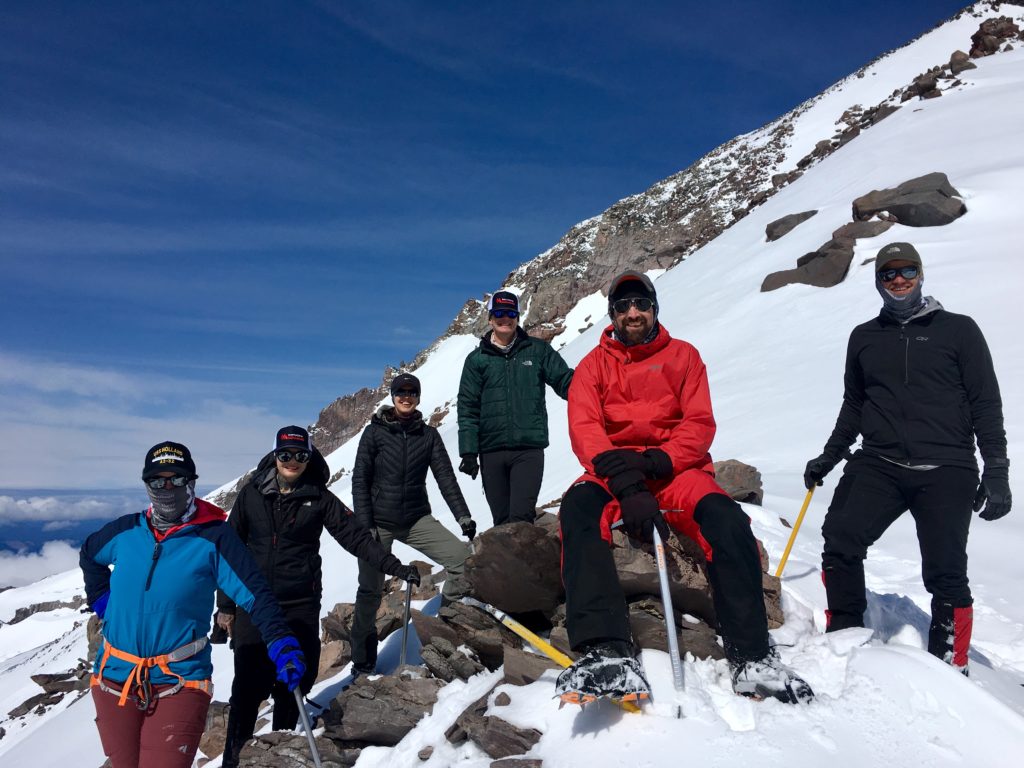
- Photo Courtesy Nate Lanting
DAY 1 – International Mountain Guides (IMG) HQ
The first day was spent at the International Mountain Guides (IMG) headquarters. The constant rain meant snow at higher elevations, and increased snow meant increased safety concerns. Spirits remained high though and everyone kept their fingers crossed for better conditions. The group arrived at the IMG HQ around 2 PM, spent time getting to know each other, talked about their favorite dinosaurs, and then met with Willie Webster, their lead guide at IMG. Together, they reviewed trip details, the itinerary, weather report, and leave no trace principles. Three hours were spent doing a gear check.
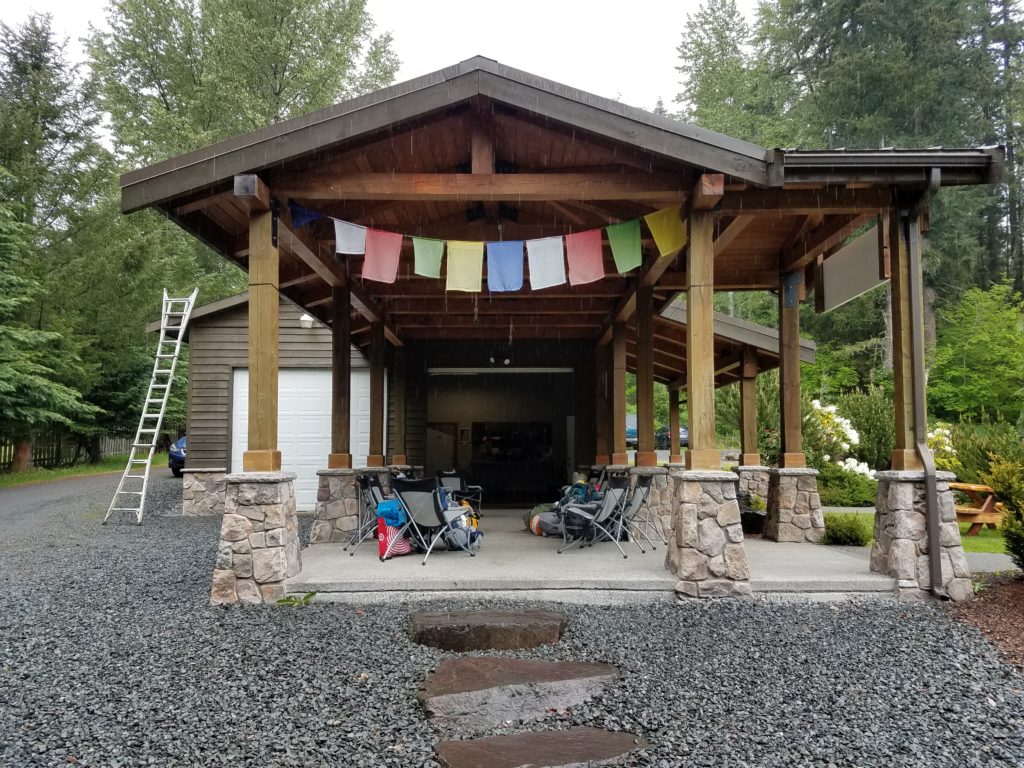
- Photo Courtesy Amelia Kaiser
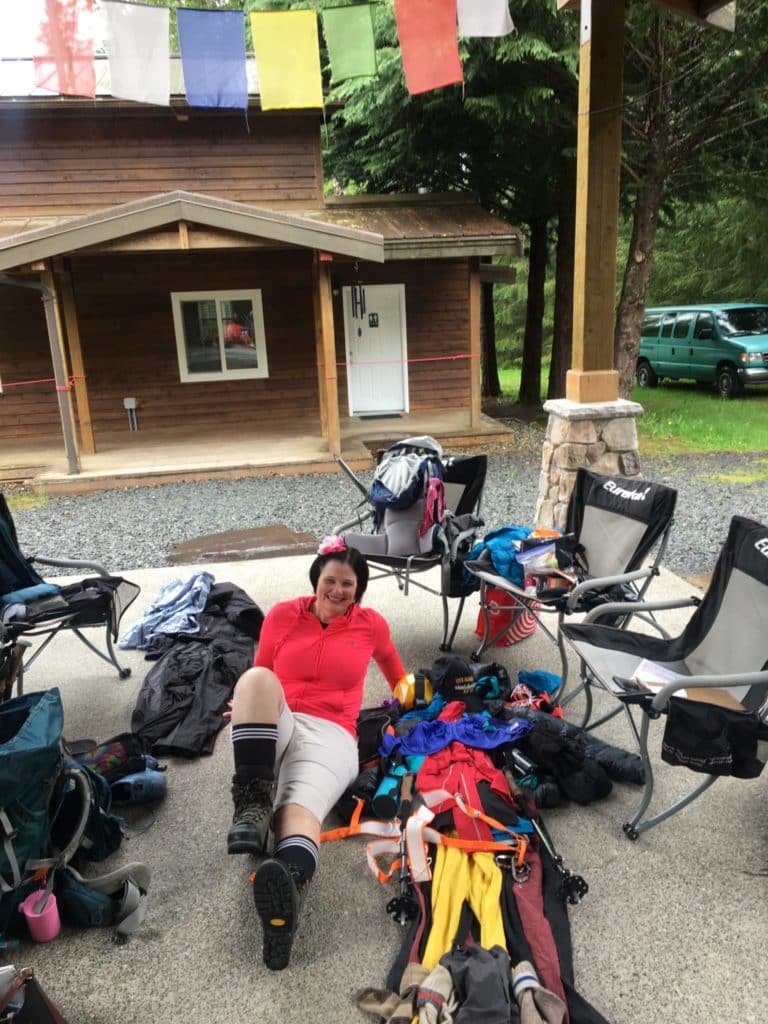
- Photo Courtesy Nate Lanting
A delicious dinner at Wildberry, a Nepalese restaurant, followed. The fundraising climbers received a Recovery Beyond Beanie (check out our store to purchase your own), water bottle, and a personalized “thank you” note from Nate, Recovery Beyond’s Program Manager, and fellow fundraising climber. The group ordered food and sat around the table sharing who they were, how they got plugged into Recovery Beyond, and why they were participating in the fundraising climb. The evening wrapped up and everyone returned to Lazy Bear Creek Cabin, a beautiful and quaint Air BnB cabin along a creek. A quick dip in the cabin’s hot tub ended the day.
The rain continued to pour all night.
DAY 2 – To Camp Muir -10,080′
The climbers woke up at 6 AM, had breakfast, and returned to the IMG HQ by 7:30 AM with their bags packed and bellies full. They were ready to start the climb! They set out from IMG around 8:30 AM and arrived at Paradise (5,400’ elevation) at 9:15 AM. At Paradise, it was cold, snowing, and the wind was blowing. The group sauntered over to a breezeway by the ranger station and readied themselves by putting on their boots, hard shell jackets and pants to keep dry, and sunscreen (even with clouds there’s still a possibility of getting sunburned).
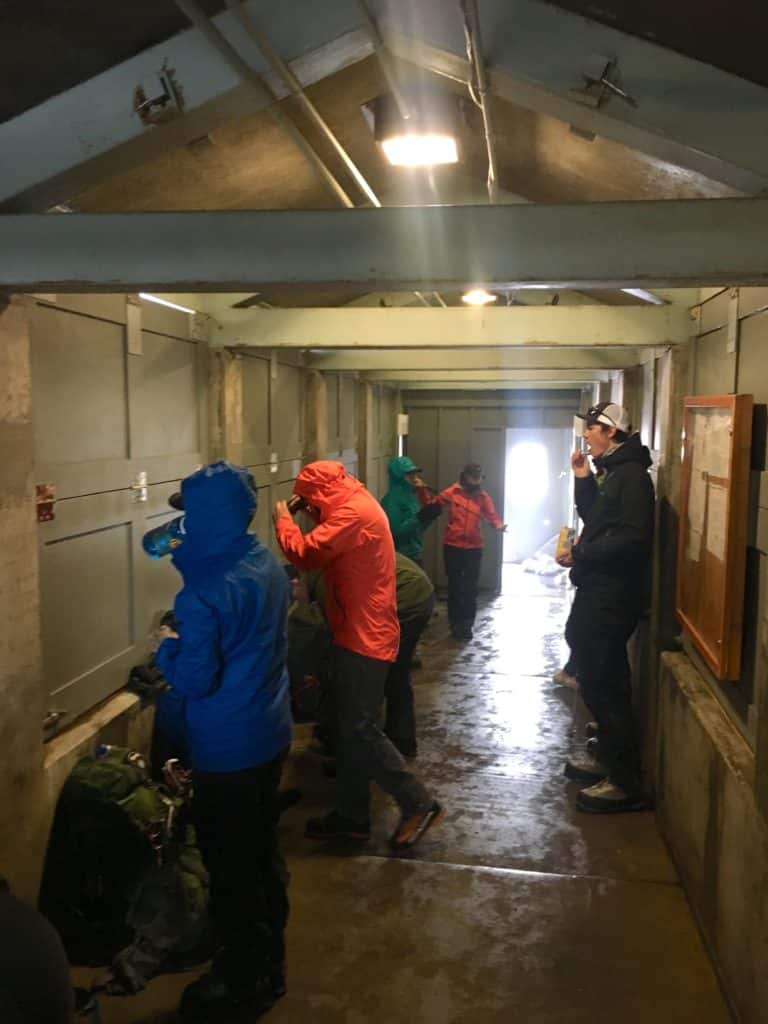
Photo courtesy Nate Lanting
At 10:00 AM, the group began the first part of the climb up to Camp Muir at 10,080’. After an hour of hiking, they paused to take a break. One of the fundraising climbers, Camiya, had to turn around due to exhaustion. She joined another IMG group that was going through snow school at lower elevations. The group pressed on, taking breaks as needed. Around 9,000’, they were above the clouds, and what a sight it was to see! The sun broke out and the top of Rainier stood before them in all her glory. The rest of the hike to Muir was beautiful. The views were incredible, and everyone took their time so they could enjoy the experience.
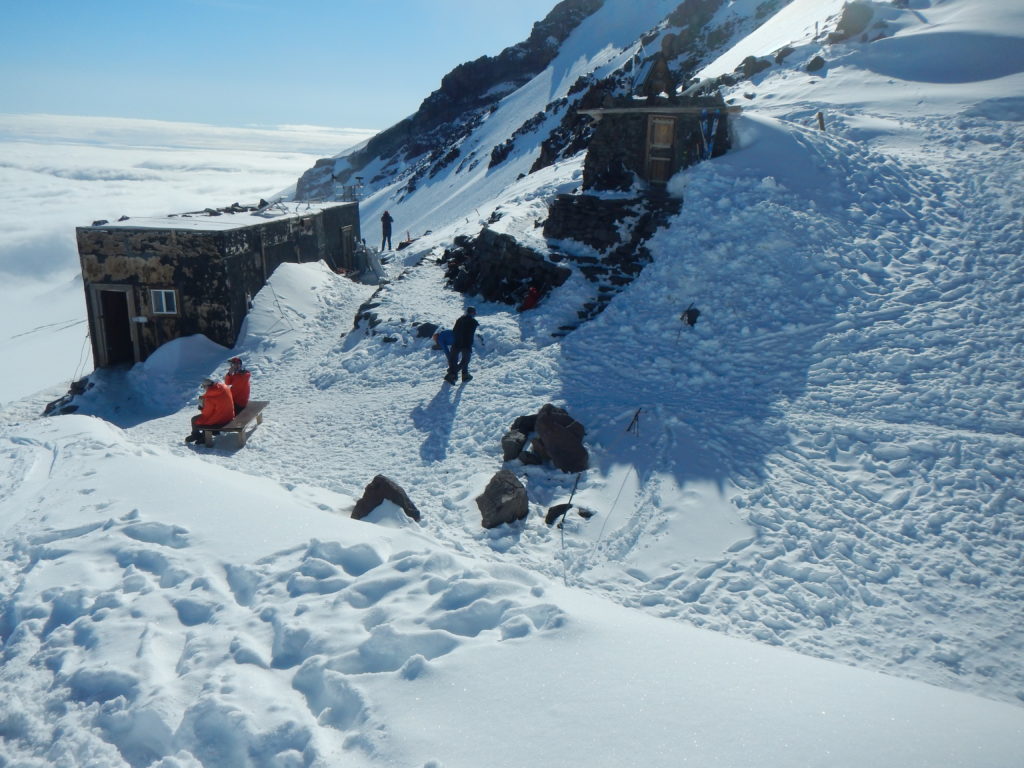
Photo courtesy Amelia Kaiser
They reached Camp Muir at 4 PM and settled into their own bunkhouse. An hour later, the IMG guides came and got them and took them on a short hike to IMG Weatherport, which included kitchen and seating. Massive burritos were served for dinner. Scott Brown and Chris Poulos ate not one, not two, but -three- full burritos. Hot cocoa and hot tea followed, and a discussion about next day ensued. The night ended around 7 PM when everyone returned to their bunkhouse. By 9 PM, all were sleeping and skies were clear.
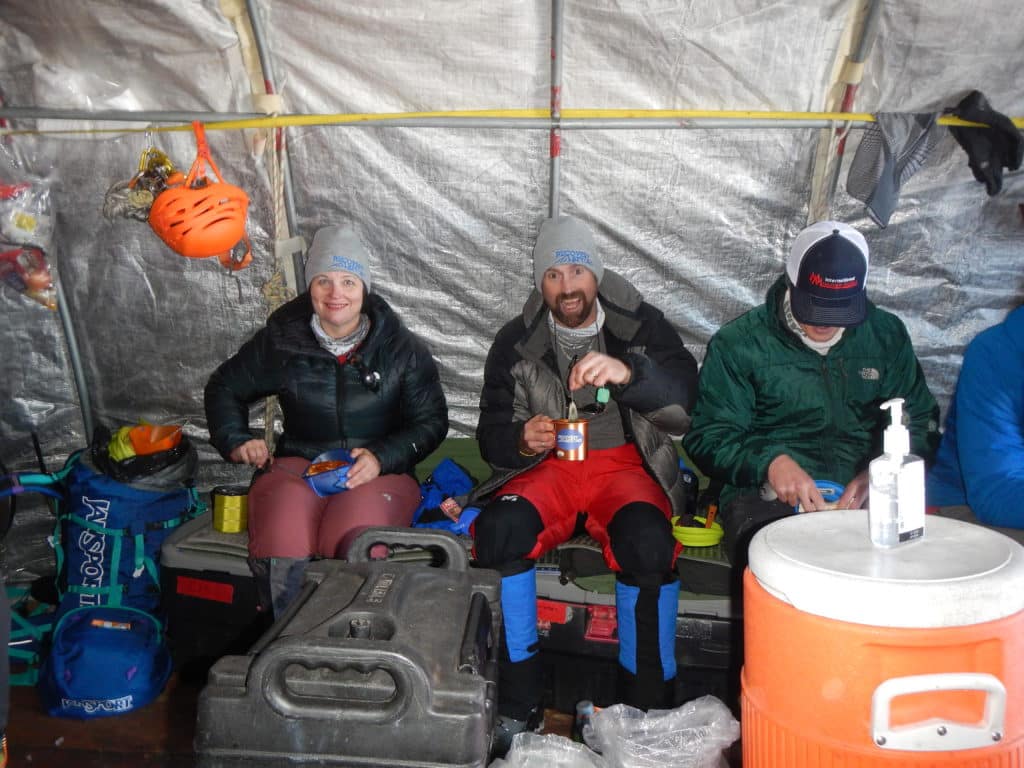
Photo courtesy Amelia Kaiser
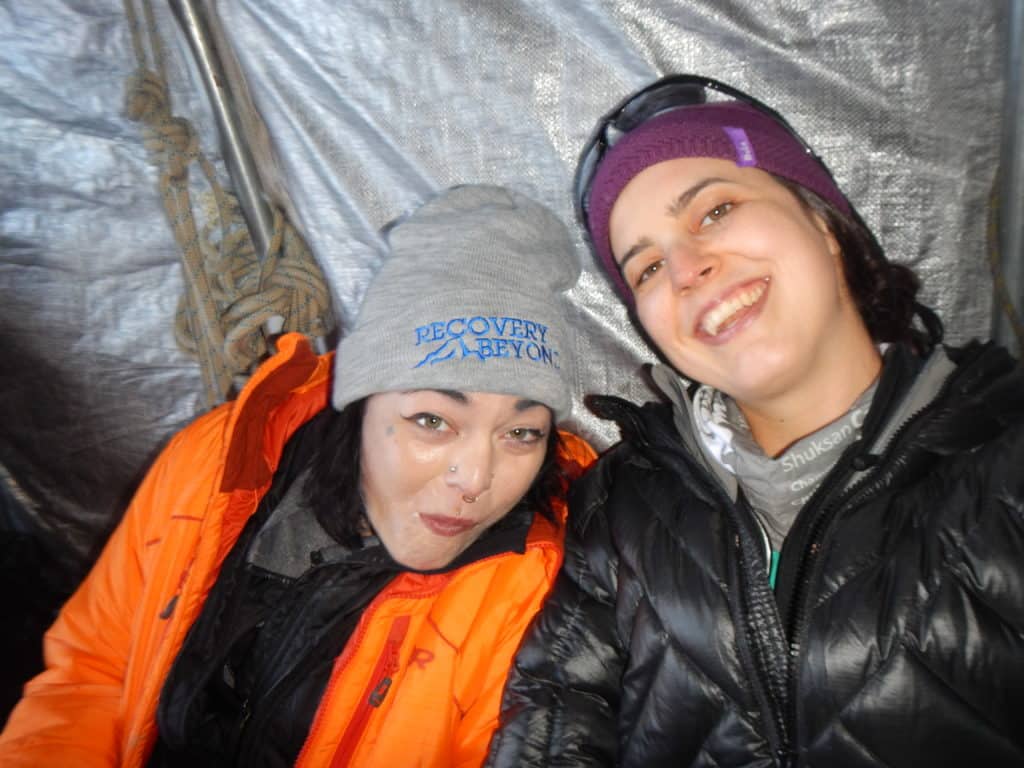
Photo courtesy Amelia Kaiser
DAY 3 – To Ingraham Flats Camp – 11,100′
Everyone arose at 7 am and packed their gear. It was cool outside, the skies were clear, and there were picturesque views of Mount Adams, Mount Hood, and Mount Saint Helens. A delectable and sizeable breakfast at IMG Weatherport consisting of chocolate chip pancakes, bacon, and French press coffee was consumed. The climbers reviewed the plan for the day: Snow school first from 9 AM- 12 PM and then a hike to “the flats” camp.
Snow school was educational. Each hour consisted of a different topic. First: using crampons, or “crampon-ing”. The climbers learned and practiced different waling techniques, such as the importance of good footwork. Second: using an ice ax and learning how to “self-arrest”. Everyone practiced self-arresting with their ice ax and feet (without crampons). A quick snack break came next, and the third hour started: Everyone put on avalanche beacons (a required practice from guided companies above Camp Muir), their crampons, and tied into the rope. Time was spent learning how to travel on the rope, and once everyone was comfortable, they headed up to “The Flats” camp. They hiked across the Cowlitz Glacier and then up through Cathedral Gap, taking time to enjoy the views of Little Tahoma. Fifteen minutes of hiking later and the group arrived at Ingraham Flats Camp.
It was beautiful up there. There were jaw-dropping views of Little Tahoma and the upper mountain. Ingraham Flats Camp was everyone’s favorite part of the trip and was an “epic” spot to camp.
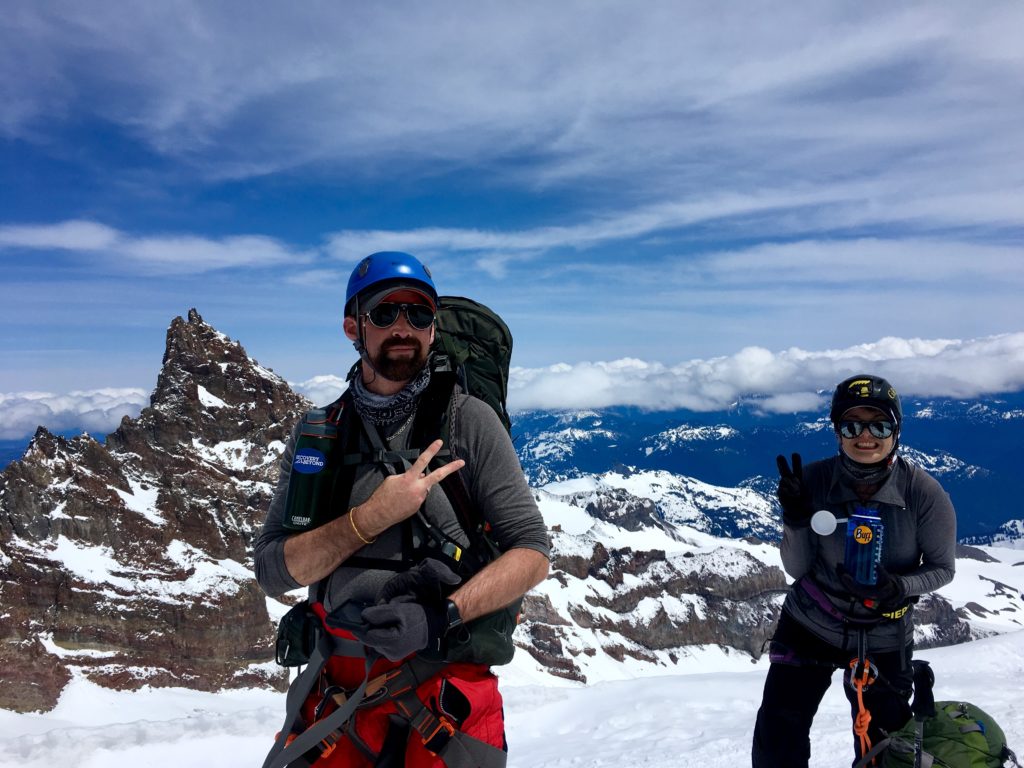
Photo courtesy Nate Lanting
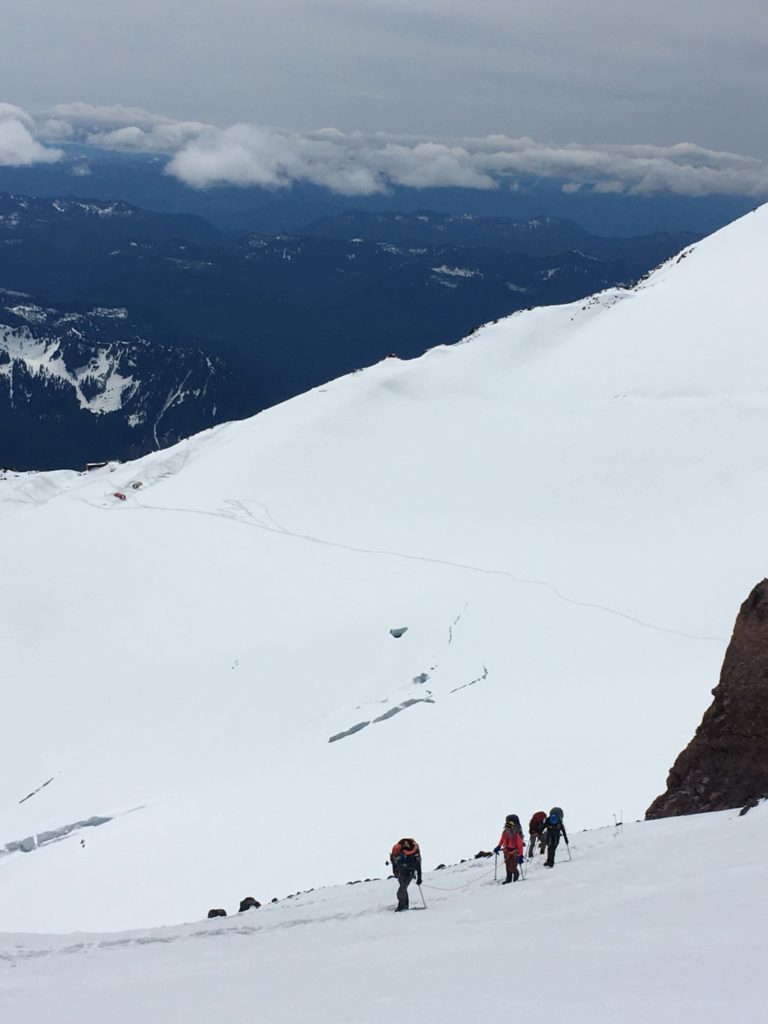
Photo courtesy Nate Lanting
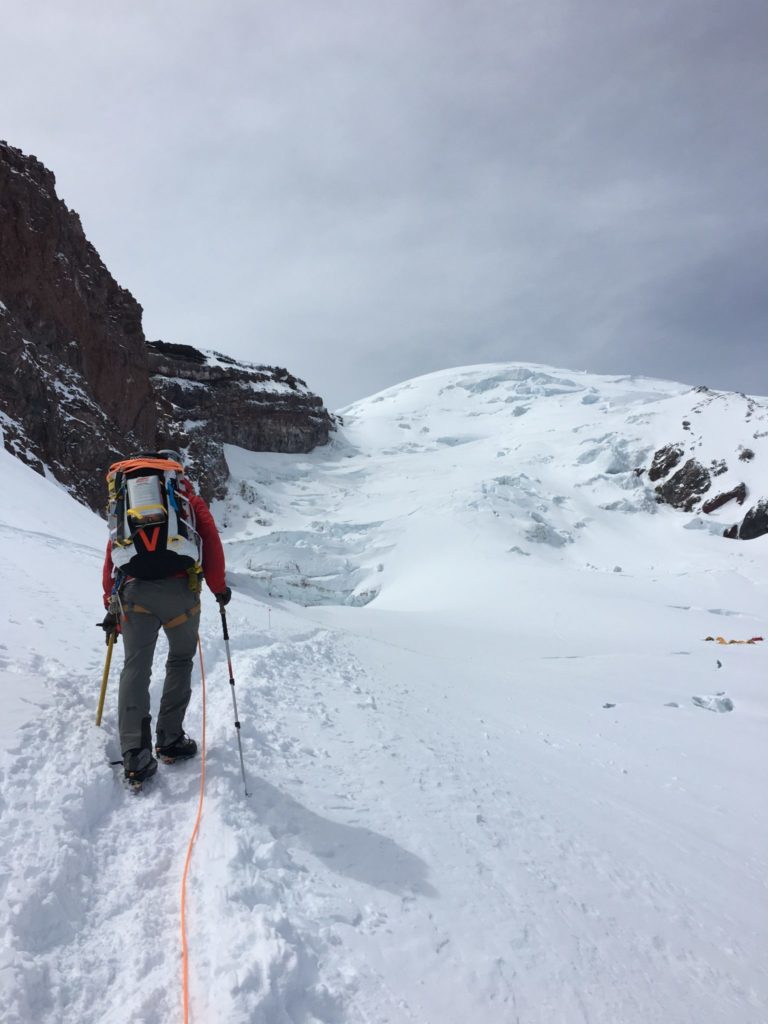
Photo courtesy Nate Lanting
Everyone settled into their IMG tents, and around 5 PM, they gathered at the IMG kitchen tent for another delicious dinner: Macaroni and cheese, vegetables, and, of course, a healthy amount of hot sauce. There was talk of the mountain conditions and the climb beginning at 2 AM the next morning. That’s when the climbers received an update on their climb. Willie Webster and the other guides shared how “loaded” the mountain was with snow, unfortunately making it unsafe to travel to the summit. Two guides had observed and cut in a trail to 12,500, making it the new climbing goal for the Recovery Beyond fundraising climbers.
Were the climbers disappointed? Somewhat, but the weather was out of everyone’s control and they knew the chance for a summit bid would be very low because of it. Mount Rainier has a weather system all her own. Our fundraising climbers made the most of this trip, though. The point of the trip was not to summit, but to raise awareness and funds for addiction recovery. They learned as much as they could from their guides, laughed a whole lot, built relationships, and made incredible memories.
“The main goal that this climb embodied was to create a sober community, both through fundraising and living it on the trip. We connected, had fun and enjoyed the adventure, all while being sober. The summit was just a bonus” – Nate Lanting
DAY 4 – Summit & Back Home – 11,500′
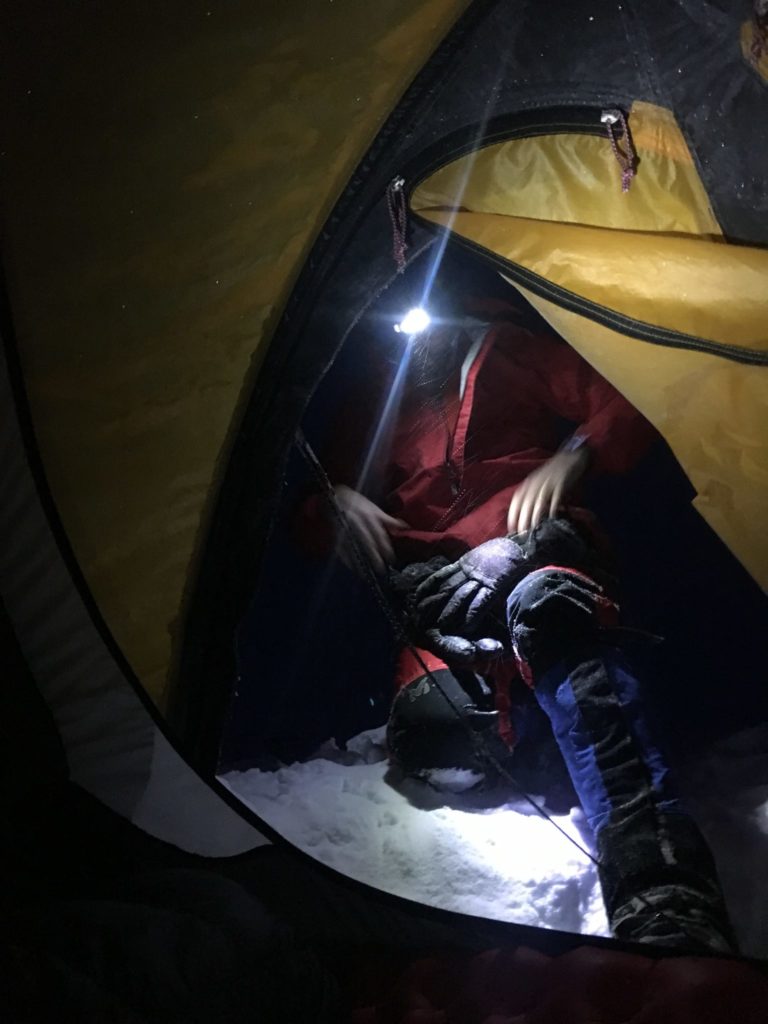
Photo courtesy Nate Lanting.
At 2 AM, Willie woke everyone up. It had started snowing at 8 PM, about two hours after everyone had gone to sleep, and by that time, there was a new foot of snow on the ground. The group prepped their glacier gear, headed over to the kitchen tent for oatmeal and coffee, put on their glacier gear setup, and readied themselves to safely go as far as possible through the new snow. Helmet, headlamp, harness, goggles, hard shells, ice axe, crampons, heavy gloves – check, all on. They began their trek through the snowy, blizzard-like, dark night. After twenty minutes, Willie, the lead guide, called it. There was just too much new snow and it was unsafe. The team topped out at 11,500’ and then headed back to camp to sleep for a couple hours until first light.
When there was light, the climbers began their descent, first setting down the mountain back toward Camp Muir, arriving there at 7:30 AM. Visibility was low, the wind was blowing, and it was snowing. A warm breakfast of pancakes and coffee at Weatherport provided a nice break from the elements before heading back down to Paradise. There were whiteout conditions until 7,500’, but the guides were able to navigate well using GPS tracking.
Our fundraising climbers made it back down to Paradise at 12:15, feeling happy, thankful, and proud. By 1:15 PM, they had arrived back at IMG HQ, had a short debriefing, award ceremony, and an opportunity to share what the climb meant for everyone. All the fundraising climbers were thankful they were able to raise money to support addiction recovery. “Thank you’s” were shared with their guide, IMG, and with each other. A quick team photo and final goodbyes were met with “Let’s do this again!”“It was a fun climb even without the summit. We all knew we were physically ready but the weather had another plan for us. The IMG experience was incredible. They communicate well, train us properly while allowing adequate time for rest and certainly having hot, fresh meals available to us was a bonus. The climb was great because normally most of us are volunteers on Recovery Beyond climbs/hikes and wear some type of leadership hat. This climb we got to kind of “let our hair down” and climb as friends. It was great. I felt like there wasn’t a better group of people to share this experience with. I also loved that we all had the common goal of fundraising for Recovery Beyond. It’s always more fun to climb with a purpose.” – Becky Vinson
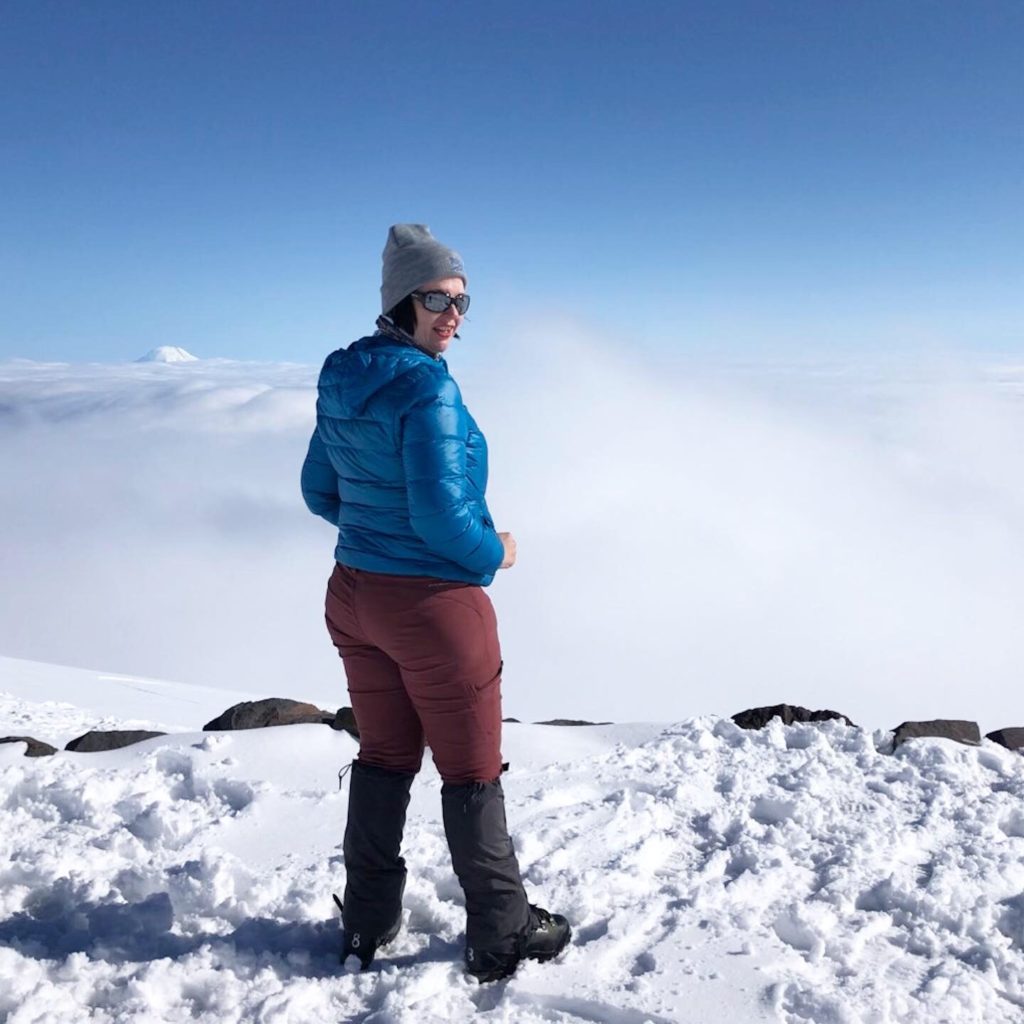
Photo courtesy Becky Vinson
While the climb is over, the fundraising continues. YOU can donate today to create healthy lifestyles for lasting recovery.
Successful recovery for an individual requires a community that supports healthy lifestyles. This is where Recovery Beyond comes in and provides a cost-effective solution to a growing concern in our communities, easing costs on our taxpayers. An 85{637c4c527fde39f83a380e19107d2ba88ad72607f37ccf8f8b7edeff1c20688c} success rate shows that what we are doing is working. We have a solution, but we need your support. We need to take action today and reduce the high addiction rates and chances of relapse.
“There’s just something about the outdoors! I am approaching almost 7 years sober and it’s obvious the difference it makes to my state of mind when I get outside either on my own or with the group. Volunteering with Recovery Beyond is not only beneficial to the sobriety of those involved but incredibly important for my own recovery as well. With Recovery Beyond I’ve found a place to belong. With Recovery Beyond I’ve found a family. To be added to their Climb Team means so much. Not just about going up Rainier but getting to be a part of this program and supporting everything it stands for. Thank you for your support!!!” -Scott B., Fundraising Climber
Donate today – because every person with an addiction deserves to live a healthy lifestyle for lasting recovery.
- The Mount Si Gift: $50 – This provides 1 program participant monthly mentorship
- The Loowit Gift: $100 – This provides 1 recovery hiker, hiking gear, 6 recovery-based hikes in the northwest, and the leadership support to do so.
- The Dakobed Gift: $250 – This provides 1 recovery climber that opportunity to go on a 3-day backpacking trip in the northwest, with a team of experts, recovery support, and all the equipment and wrap around support to do so.
- The Kulshan Gift: $500 – This provides 1 recovery climber that opportunity to climb to the top of Mt. Baker with a team of experts, recovery support, and all the equipment and wrap around support to do so.
- The Pahto/Klickitat Gift: $1,000 – Provides 5 months of recovery based mountaineering programming, including 6 training hikes, 2 educational seminars, and 2 mountaineering trips to one person in addiction recovery
- The Tahoma Gift: $5,000 – One calendar year of outdoor recovery & therapy, through weekly fitness classes, monthly community hikes, mountaineering and backpacking expeditions, and recovery-based mentorship, for one person in addiction recovery
Check out individual fundraising pages to make your gifts.
DONATE NOWThank you for your help in creating healthy lifestyles for lasting recovery.
Please share this post on social media. Invite your friends to make a gift – no gift is too small and is greatly appreciated.
-
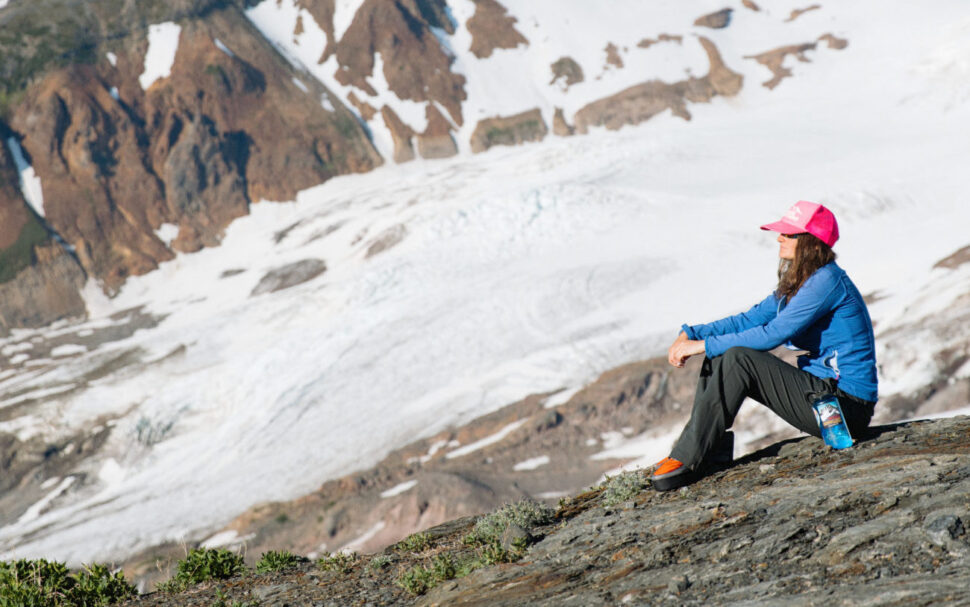
McKenzie Johnson, a Recovery Beyond Super Volunteer
If you’ve ever checked out Recovery Beyond’s Facebook page or Instagram account, you’re more than likely familiar with the friendly, smiling face of McKenzie Johnson, one of Recovery Beyond’s “super” volunteers. In the photos shared, you might see her standing atop a mountain she’s just climbed grinning from ear to ear or proudly posing with a group of Recovery Beyond’s program participants on a training hike that she has led. If you’re like me, you may know McKenzie’s name from a Washington Facebook hiking and climbing page called the Washington Hikers and Climbers, a place where McKenzie has shared her story of recovery and adventures in the mountains over the years.
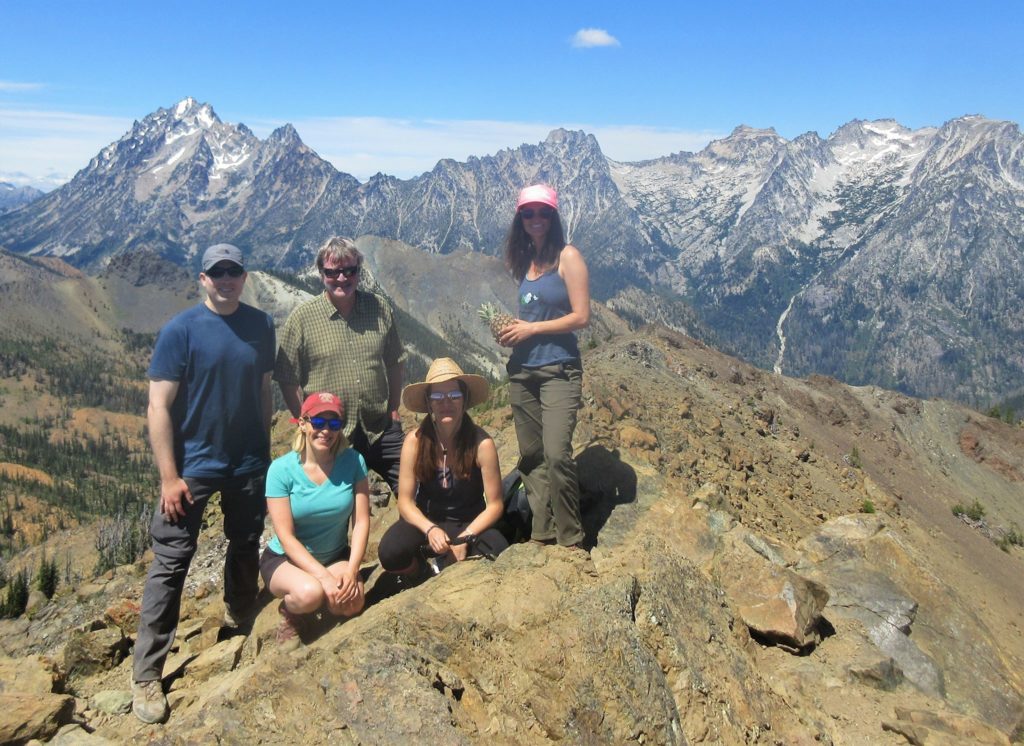
Photo Courtesy: Lee Jacbonson, Washington Hikers & Climbers
McKenzie is very involved with her community and the causes that are closest to her heart. The creator of Washington Hikers and Climbers, Lee Jacobson, stated, “[McKenzie] is a rock star on the WHC page, and last year, I auctioned off a hike with her on the page (to Earl Peak), and we raised more than $2,600.00 for Kittias County Search and Rescue.” Professionally, McKenzie fights blood cancers with The Leukemia and Lymphoma Society through fundraising. She coordinates and promotes The Winter Pineapple Classic, a 5K Obstacle Course fundraiser and promotes and fundraises for another LLS physical challenge, The Big Climb. She does this for her mom and for loved ones and friends of loved ones who have blood cancer or have lost someone to blood cancer.
About a year and a half ago, Nate Lanting, Program Manager for Recovery Beyond, reached out to McKenzie via the Washington Hikers and Climbers group. He asked her if she had seen, A New High, a documentary about Recovery Beyond program participants from the Seattle Union Gospel Mission who trained and climbed Rainier. McKenzie had her whole family watch the documentary, excitedly feeling a connection to many of the program participants. A few weeks later, she messaged Nate back and asked how he got gear for Recovery Beyond’s program participants. She then offered to help the organization get gear donations. That’s when her relationship with Recovery Beyond began.
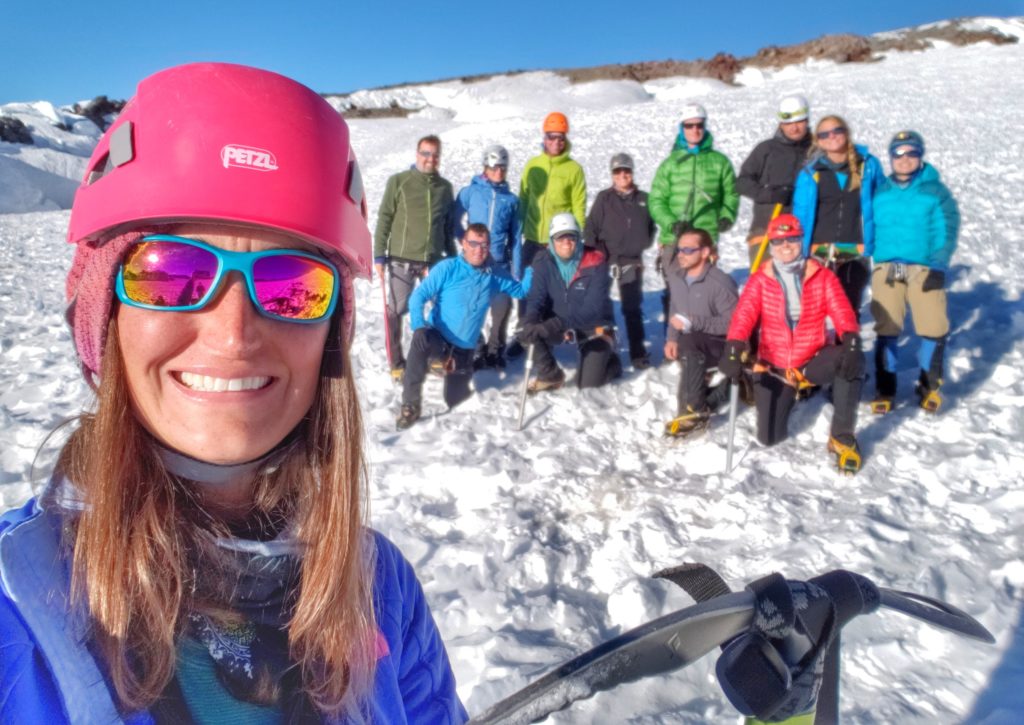
“McKenzie is on the front lines, bringing our message of hope and community to the larger recovery and mountaineering communities in the Seattle/Tacoma area. Her efforts on our social platforms and through her work as a volunteer have taken the organization to new heights and driven awareness for our cause in ways we couldn’t have imagined.” – Christopher Mohs, Marketing and Digital Volunteer
McKenzie’s passion for Recovery Beyond stems from her personal experience in recovery. McKenzie has been in recovery from alcoholism for almost 7 years (June 20th will be 7 years) and kindly shared her whole story with me. She grew up in Seattle in an upper-middle-class family and had a relatively normal childhood. However, she blamed her parents for certain things (later in recovery it became clear that her parents were never the problem), and in high school developed an eating disorder. She wanted to be as independent of her family as possible after high school in order to “hide” her addiction, so she moved down to California to attended CalPoly college. As a soccer player, she could’ve played competitively, but a preconceived idea of what the college experience was supposed to be like caused her to focus more on drinking. Her eating disorder eventually morphed into alcoholism and she became a full-blown alcoholic.
McKenzie made herself independent from her parents so they couldn’t have control over her life. She tried to outrun her addiction but eventually realized that because addiction existed in her head, she could never outrun it. She lived in California for ten years, moved to Australia for a year, and then moved back to California. She knew for two years before she got sober that she needed to stop drinking. McKenzie’s sister was a driving force for getting her into treatment. In 2012, she finally asked for help and went to treatment in Vancouver, Canada for five and a half months. It was there that she was taken to a climbing gym, one of the activities that were offered as part of the program. Despite her fear of heights, she fell in love.
While in treatment, her dad packed up her stuff in California and drove it to Seattle. Once she finished treatment, McKenzie had no place to go except home, which was a place she was scared to face again. Home was where everything had started for her. After she finished treatment, she went back to Seattle, though. She went to AA but wanted to keep her focus on recovery with a hobby she enjoyed as well. Knowing how much she had enjoyed climbing while in treatment, she decided to join Stone Gardens. She took classes, met a friend, and started climbing outside.
As McKenzie got more and more into climbing, her mom grew increasingly concerned for her safety. She suggested that McKenzie look into climbing with Alpine Ascents. McKenzie picked up a 6-day mountaineering course on Baker with only four months to train, and even though it was the hardest thing she has ever had to do, it was also the most amazing. She fell in love with glaciers on this climb. To this day, it’s where she wants to be. She says she’ll never forget the weather because it went from being awful (pouring rain) to being amazing on summit day. After this climb, she started climbing more independently, took an immediate course the following year, and then climbed Rainier in 2014.
One of the biggest takeaways from treatment McKenzie says is that you CAN have fun without drinking or doing drugs. Successful recovery requires more than just attending AA and therapy. Finding a hobby is just as important and climbing became her hobby. The mountains have been a huge part of her recovery. Her family has also been incredibly supportive.
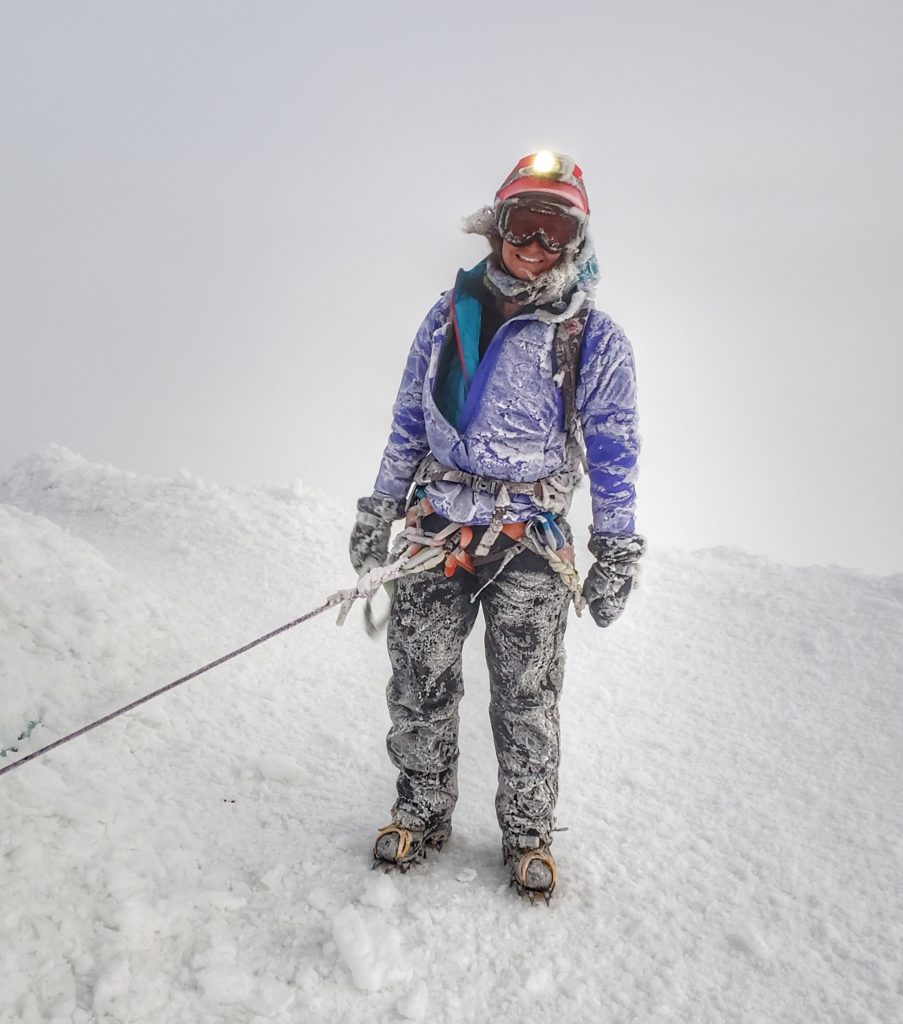
“You may not know it, but McKenzie has played a huge ‘behind the scenes’ role in supporting and growing Recovery Beyond. Between her in-field leadership, recovery mentorship, running countless errands, regular program advising, managing our social channels, and sharing her large network of resources with us, she has played a significant part on our team. McKenzie is hands-down the most supportive and helpful volunteer we have, she might as well work for Recovery Beyond! But I think she likes it that way; a way to give back, to recover, to enjoy the organization, while staying behind the scenes and watching it grow. She has given so much, and we couldn’t do this stuff without her. Period.
I think the best example that displays this is how she has shown up. McKenzie has been at nearly every hike, lead on every mountain trip, been at every briefing and orientation, volunteer hours getting gear and meal packs prepared, opened her family’s studio for us to use 3-4 times for community events.
She is smart, constantly giving good advice about organizational development, or who should meet who for recovery reasons, as well as executes any responsibilities delegated to her.” -Nate Lanting, Recovery Beyond Program Manager
When a person is filled with passion in the way that McKenzie is, it is hard not to feel inspired by them. After talking to her on the phone, her humble and down to Earth nature makes me wonder if she is fully aware of the impact she is having on others. She is authentic, strong, selfless, and grounded. She truly believes that you can do anything you set your mind to. Even though the hikes and workouts that Recovery Beyond offers can be physically hard, she believes that they are nothing compared to what program participants have been through with their addictions. McKenzie inspires others and encourages them to be who they want to be and to challenge themselves. She relates to the participants because she sees herself in them. Her recovery story is like their stories. McKenzie’s biggest pleasure now is seeing someone’s face light up with joy when they go outside.
Back to that “super” volunteer concept: What is a “super” volunteer, you may ask? McKenzie. Hands down, McKenzie. I asked her how many hours she has put into the organization, and last year she said she volunteered about eight to ten hours a week of her time. She went on every hike except one. She helps with social media and is a lead mountaineer guide on teams. What doesn’t she do? To top it all off, she is AIARE2 certified and WFR certified. And she is an ice climber.
“McKenzie is one of those people who just exudes life – she is constantly on the go and working to make things better for others. She is always ready to offer good ideas and to roll up her sleeves to make things happen. McKenzie excels at anything related to social media and getting a message across. She has relentlessly volunteered her time and talent for Recovery Beyond in ways too numerous to count. What a pleasure she is to have involved and to working on our behalf. We can’t thank her enough.” – Gina Haines, Executive Director of Recovery Beyond
McKenzie gets way more out of her experience with Recovery Beyond than she puts into it, she says. She believes that volunteering is a great thing in and of itself, but she also believes that it makes you a better person and helps you grow. McKenzie would like to thank Nate, Becky, and all the program participants who have become like family to her.
To anyone interested in volunteering with Recovery Beyond, McKenzie states that it is a growing organization and that you can seriously make a difference. If you want to help, don’t be shy about it! Send your ideas our way. Even something as small as sharing our Facebook posts or one story on a page makes a difference.
Follow your passions, she says.
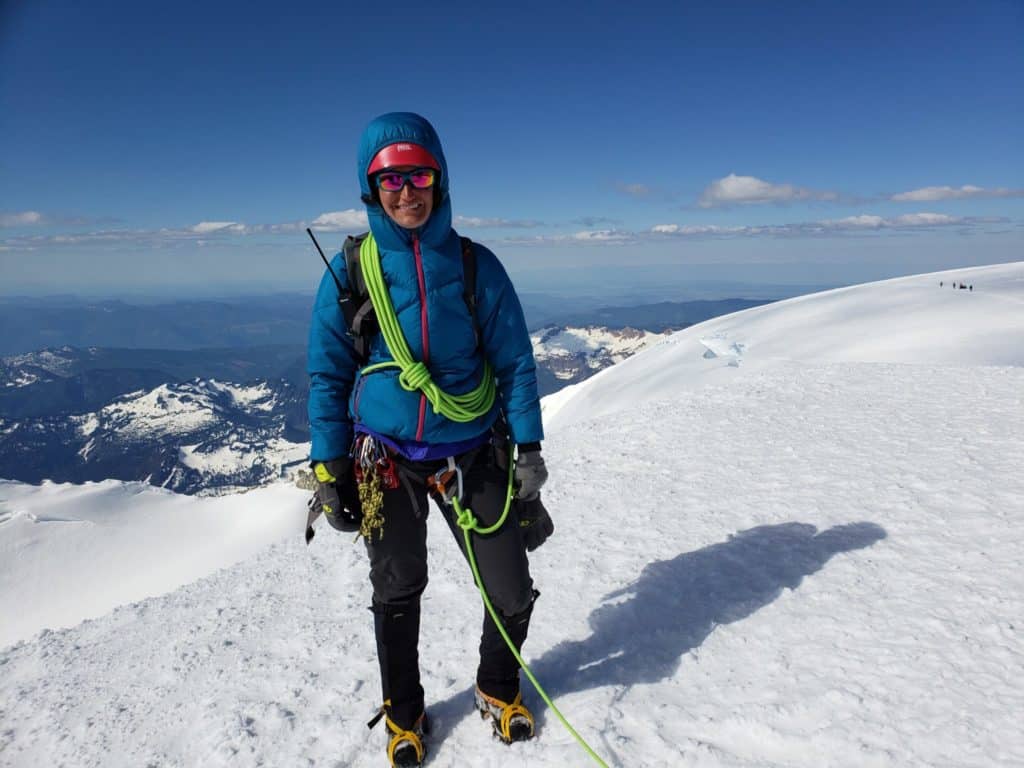
Thank you, McKenzie, for helping our program participants be successful in their recovery. This is why we’re here and why we do what we do. Thank you for everything you have done and continue to do to make this organization what it is today – to build healthy lifestyles for lasting recovery. You are appreciated more than you will ever know and Recovery Beyond is beyond thankful for your time, your dedication, your skills, your encouragement, your compassion, and your selfless and giving nature.
It’s amazing what the mountains can do for someone, how they can change lives, and what can happen when you know you can do anything you set your mind to.
Happy climbing, McKenzie!
-
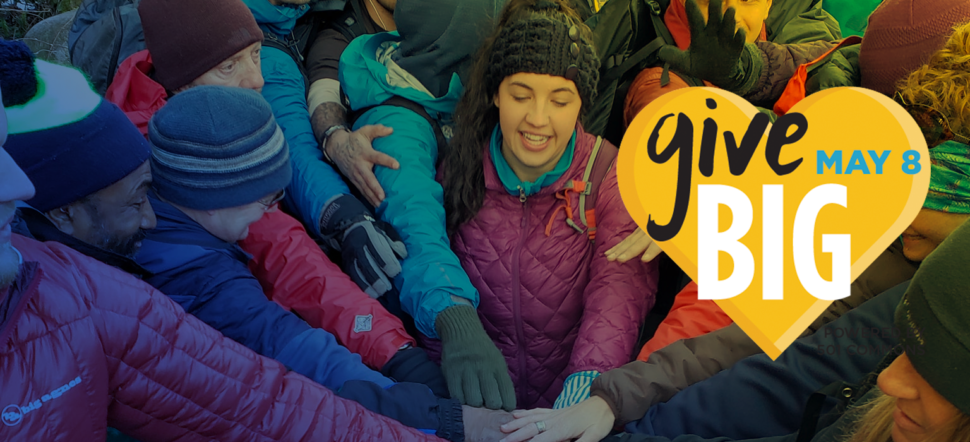
Give BIG: Everyone Has A Mountain.
For GiveBIG this year, we are asking for your help.
The need for more recovery programs is greater than ever. Substance use is a major, ongoing, and growing concern in our families, social circles, and communities. The opioid epidemic is not getting any smaller. Other substance use is rampant. Addiction is a disease and we need more options to fight it.
Recovery Beyond offers a unique approach to recovery, going beyond the norm. Through mountaineering, exercise programs, hiking, backpacking, mentoring, and community support, Recovery Beyond offers a one-of-a-kind approach to recovery that is tailored toward the interests of our participants.
We help our program participants climb mountains both physically and metaphorically.
Sustained recovery through healthy lifestyles IS possible and IS what we do best. What we are doing is working and we see the need to continue growing.
Over 85% of our program participants have successfully achieved sobriety in a lasting and meaningful way over the past three years.
That is an incredible success rate and we want to continue to increase that rate by supporting the needs of our participants and community.
We are a solution. We provide a newfound sense of purpose and direction in life for our program participants. We build skills, confidence, endurance, and teamwork. Recovery Beyond is a positive community, a place where the human spirit is inspired, and the soul restored.
We need your help, though. Please consider a gift to Recovery Beyond for GiveBIG this year.
Your donation will help build, support, and expand our programs and services, as well as complement the efforts of established recovery programs (such as The Seattle Union Gospel Mission and The Tacoma Rescue Mission). GiveBIG 2019 is a twenty-four hour online giving event powered by 501 Commons that helps nonprofits raise funds to support their mission. Whether you gift ten dollars or a thousand dollars, every dollar matters in helping us transform lives.
From the bottom of our hearts, we sincerely thank you for your generosity and support.
DONATE THROUGH GIVE BIG!You can also donate directly via our “Donate” button at the top of this page.
-
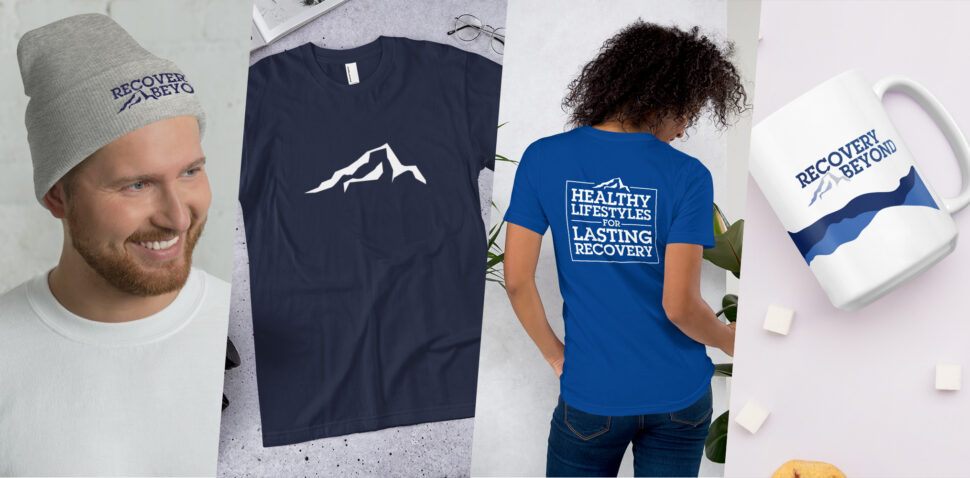
NOW OPEN! The Recovery Beyond Shop
“There are only two days in the year that nothing can be done. One is called yesterday and the other is called tomorrow, so today is the right day to love, believe, do and mostly live.” – Dalai Lama
So, you love to climb, you love supporting our recovery climbers, and you’re a big fan of the work of Recovery Beyond? Well, now’s your chance to wear that pride with the introduction of our new shop! We just launched a series of products that highlight our new brand and we think you’ll love them!
The new shop benefits our recovery climbers and our programs. We curated a range of clothing options, a motivational poster, coffee mug, and some great hats for your next climb.
Check out the store and show your support for Recovery Beyond! We also invite you to tag @recoverybp when sporting your favorite Recovery Beyond logo wear, we’d love to see your new threads.
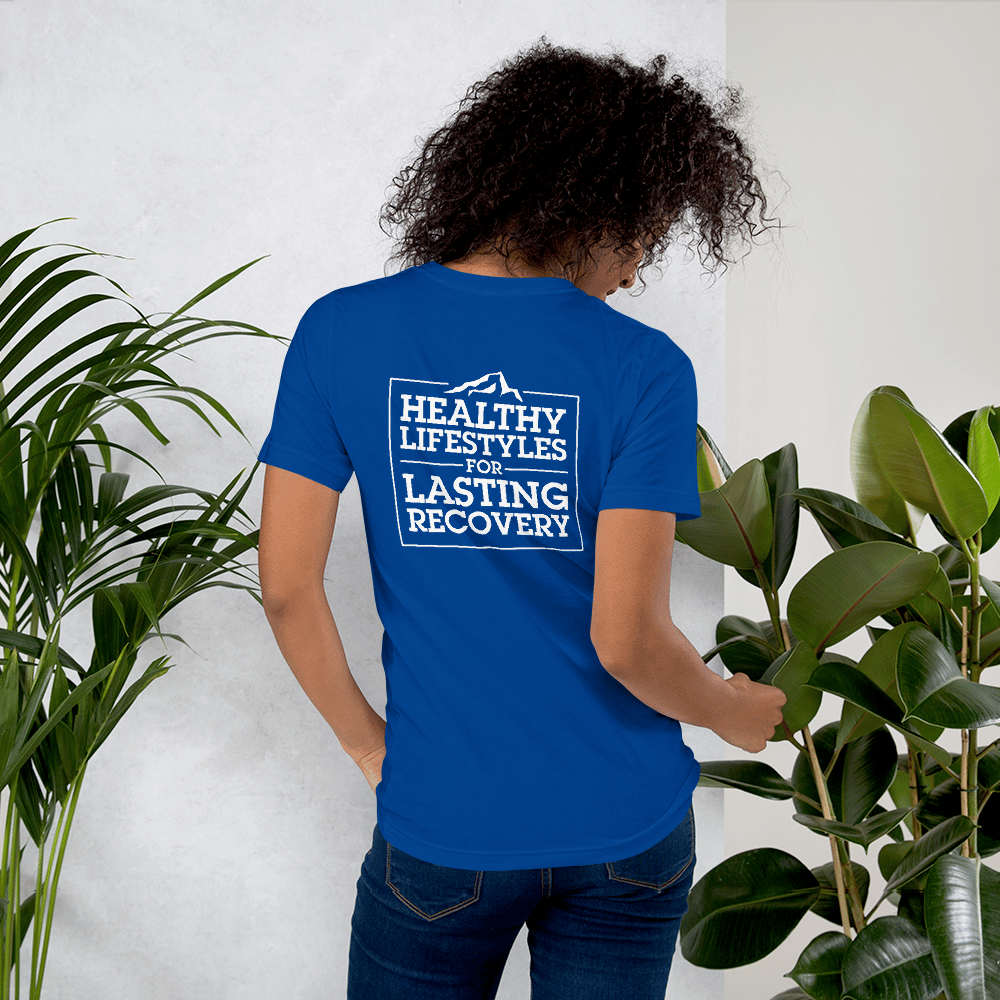
Unisex t-shirt in true-royal blue featuring our tagline “Health Lifestyles for Lasting Recovery” on the back and our logo on the front. $30
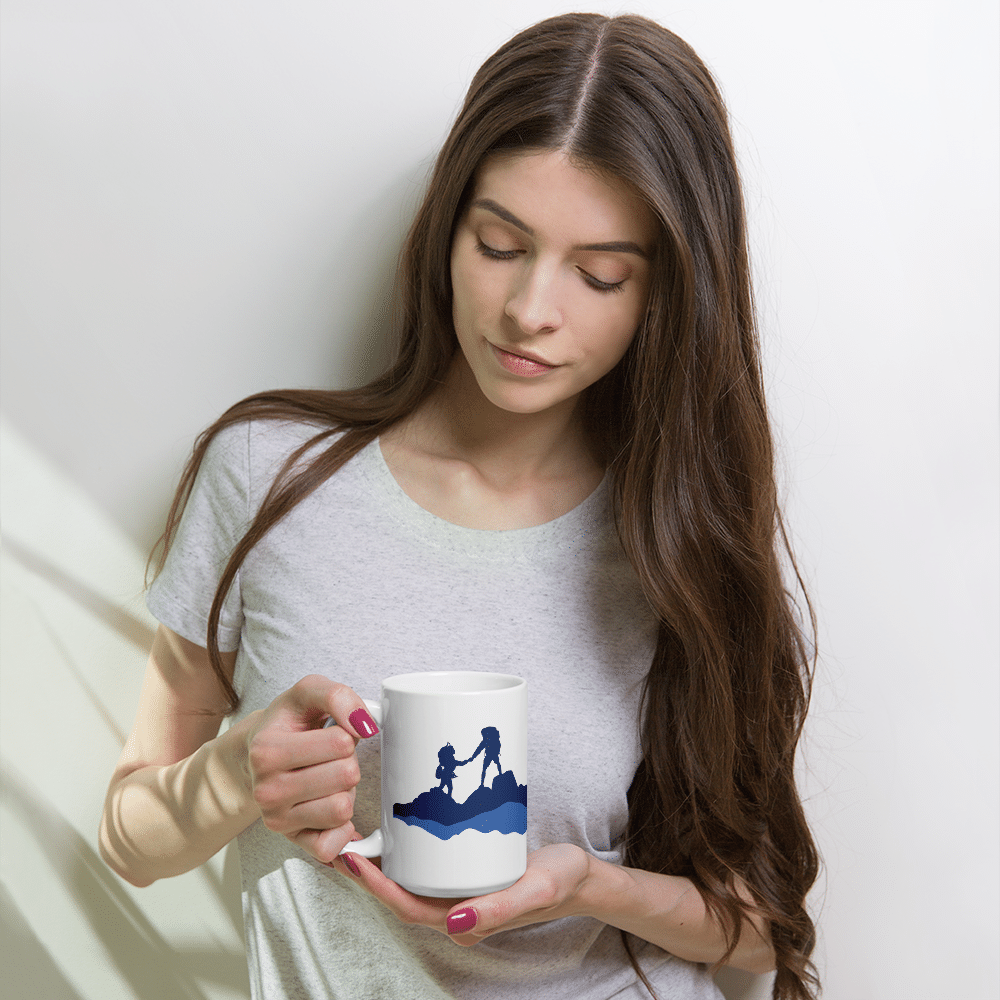
15 ounce coffee mug with our climber motif and a wrap of mountains to our Recovery Beyond Logo on the reverse side. $15
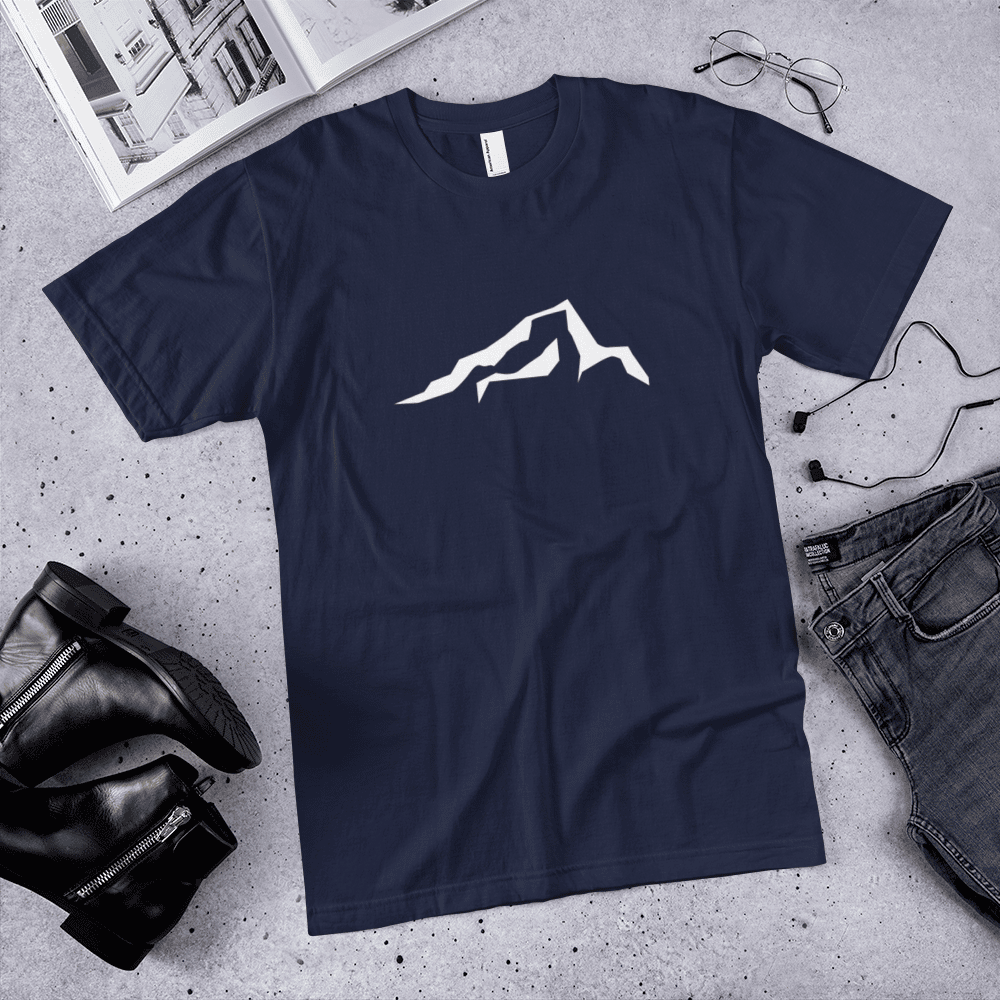
American Apparel T-Shirt with the Mountain emblem on the front. $30
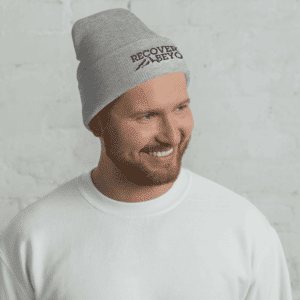
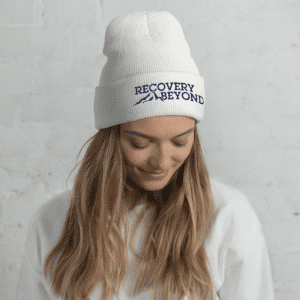
Unisex beenies in three colors – grey and white (shown) and navy with embroidered Recovery Beyond Logo. $20
Check out the entire line today!
SHOP THE STORE! -
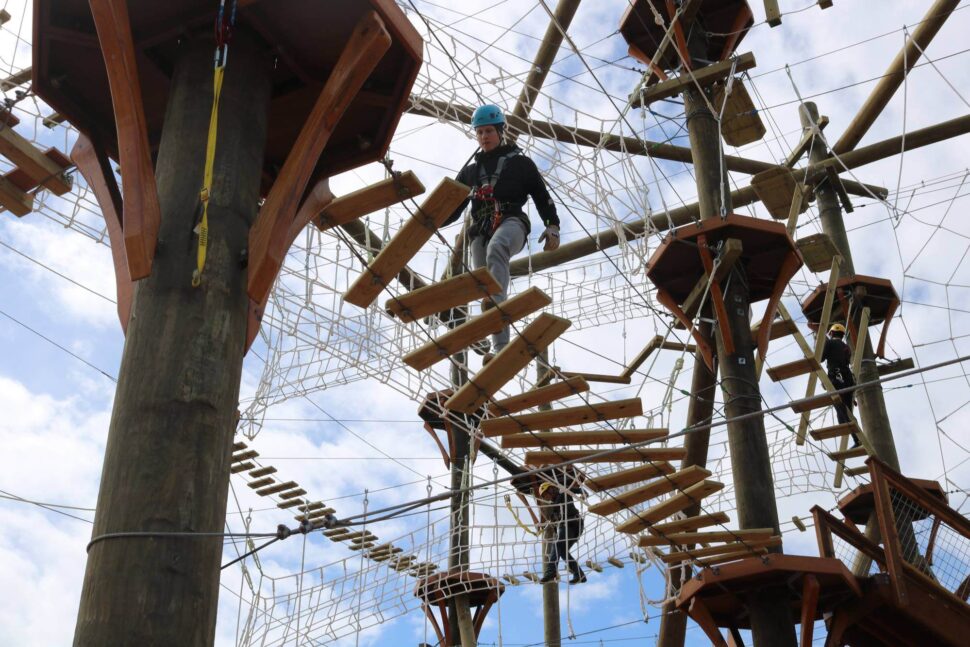
High Trek Adventures Supporting Recovery Beyond
We’re thrilled, literally and figuratively, to announce that High Trek Adventures is offering a promotional discount for anyone wanting to book an event with the company. Even better, they will be making a 10% donation to Recovery Beyond to support our recovery climbers and program participants.
If you are looking for a great place to have a team event that is lots of; full of energy and that everyone will love, this is an opportunity you don’t want to miss. If you have not been to High Trek Adventures, then you are missing a great adventure. Brad Halbach and his team offer an entire adventure park that is great for team building events or just a day of fun.
Want to know more? Check out this video they created for the promotion.
Click below to learn more about the promotion details and timing. Don’t miss out on a fantastic team or family event!
LEARN MORE @ HIGH TREK ADVENTURES -
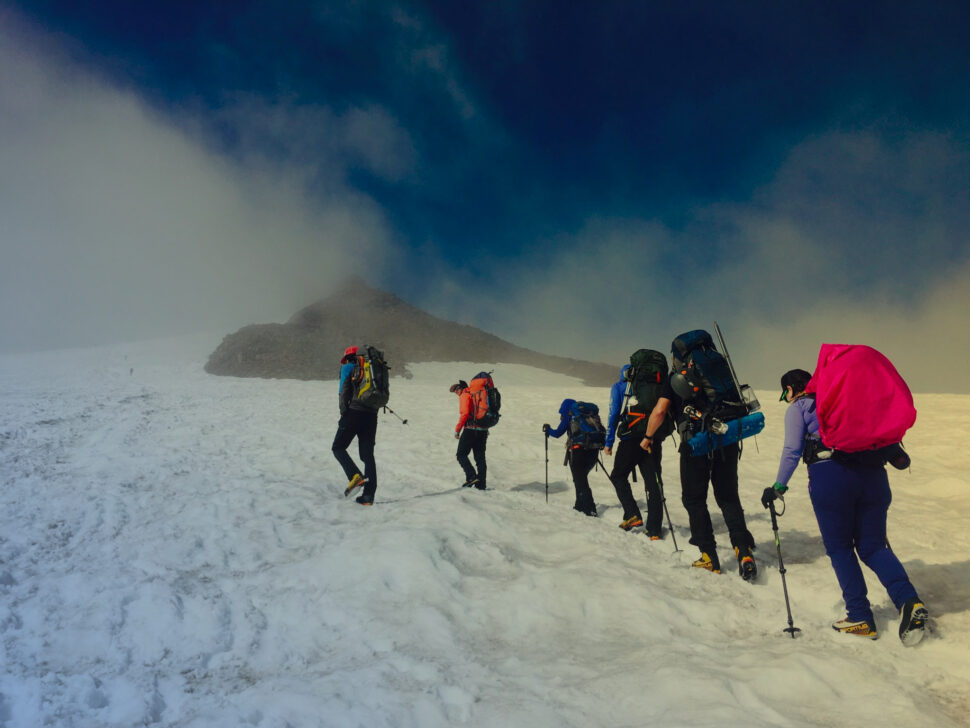
Support Our Fundraising Climbers!
From May 16-19th this year, a group of 7 supports of Recovery Beyond will embark on a climb of Mount Rainier. These individuals answered a call and challenge put forth by our founder, Mark Ursino over the past several months to dedicate themselves to this climb, and to raising money to support our efforts.
A big thank you to Abi Brewer, Camiya Brown, Christopher Poulos, Nate Lanting, Scott Brown, Amelia Kaiser, and Becky Vinson for stepping up to this challenge. Their efforts so far have resulted in over 100 individual donors for Recovery Beyond. The funds raised help support our efforts to reach and help even more recovery climbers and to grow our program.
Please consider making a contribution today to one of these Fundraiser Climbers and learn more about what motivates them on their campaigns. And beyond a donation, please tell your friends and family about this great and worthy cause. It’s our community of compassion that makes the difference every day and we are thankful for your spirit and action.
Here are some of the comments we’ve received from donors to the Fundraising Climb.
“Our daughter Amelia Kaiser volunteers with this amazing program. The stories of her time with Recovery Beyond have inspired us to support this wonderful group of people! We pray for all involved and encourage you to keep up the good work of changing lives for the better! God bless you!!!” – Elaine Klein
Visit Amelia’s Fundraising Page“Recovery tools and creating a pathway to feeedom is important and crucial for the success of people. Thank you Christopher for making this fundraiser and bringing hope into the community.” – Carolina Landa
Visit Christopher’s Fundraising Page“Scott Brown is someone who encourages all the program climbers. A joy to be around – glad to help!” – Price Taylor
Visit Scott’s Fundraising Page“Go get it girl!” – Cheryl Ann
Visit Camiya’s Fundraising Page“If anyone deserves to stand on that summit, YOU do!! It felt wrong for me to get to the summit last year while you didn’t. I am so proud of your tenacity and courage and I’m more than happy to help donate for your fund-raising climb in 2019. Godspeed, friend!” – Michele Arnold
Visit Abi’s Fundraising Page
Visit Matthew’s Fundraising PageIf you are interested in joining them, it may not be too late, but time is running out. Email Gina Haines at [email protected] for more information. Let’s celebrate their awesome commitment to a healthy lifestyle and supporting others in achieving it.
-
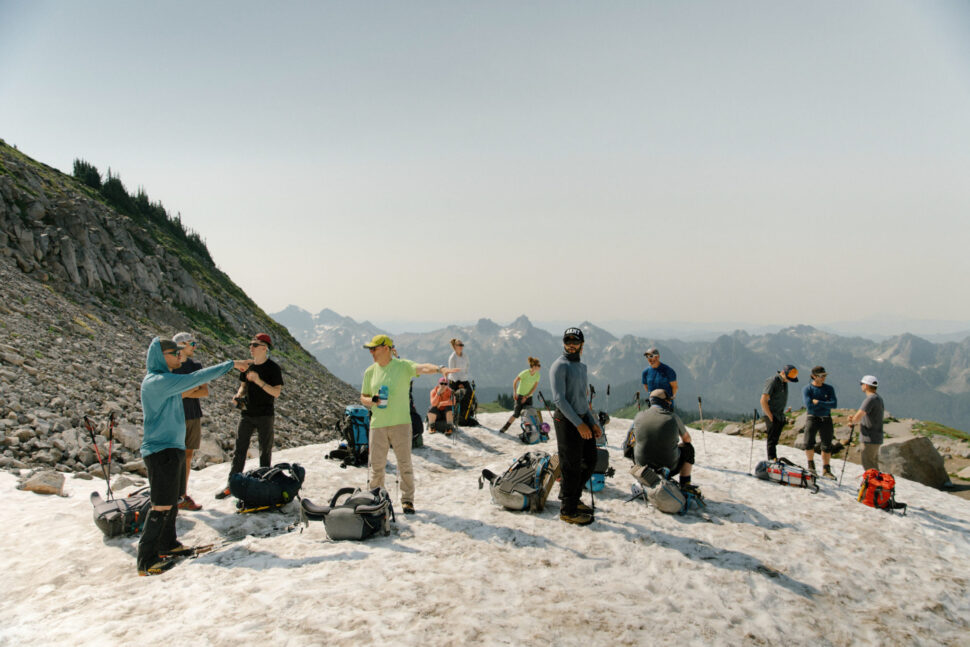
National Volunteer Month
In honor of National Volunteer Month, Recovery Beyond would like to recognize our hard-working, dedicated volunteers. From our six super volunteers, McKenzie Johnson, John Colver, Becky Vinson, Scott Sowle, Alison Powell, and Stephen Stanford, to our current group of growing volunteers, we appreciate you and everything you do. Without our volunteers, this organization would cease to exist. At the heart of any nonprofit are its passionate volunteers; individuals who carry out the work that needs to be done to meet the mission and vision of the organization. Recovery Beyond’s goal is to build “healthy lifestyles for lasting recovery”. Our model depends on people helping people. We simply could not do this work with our staff alone.
Healthy Lifestyles start with healthy relationships. There is a certain connection that happens when people come together with common interests, when they strike up a conversation, and when they discover that they share similar past experiences, challenges, and dreams. Because of these important connections, we have been seeing higher success rates with our program than any other treatment program. Our volunteers have stated that they receive as much from the interaction with the program participants as the program participants receive from the volunteers. It’s a beautiful story, really. Often the volunteer-participant relationship grows into a friendship, which then grows into a support system. There is mutual giving, sharing, and commitment to long-term sobriety and health. It’s real and it’s good for all of us.
Recovery Beyond has an impressive support network comprised of individuals from all walks of life, with different stories, experiences, and backgrounds, but with one similar goal: to be a positive support for our program participants. We are building a program that works and we are doing it with the help of our community – our volunteers.
Thank you to every volunteer, in every capacity, for everything you do. We appreciate your time, your dedication, your expertise, your experience, and your passion. You make a difference and this month, we celebrate and honor you.
Interested in being part of our positive, growing community to help those in recovery? Please check out our range of volunteer positions below. We’re excited to have you join us!
SIGN UP TO VOLUNTEER -
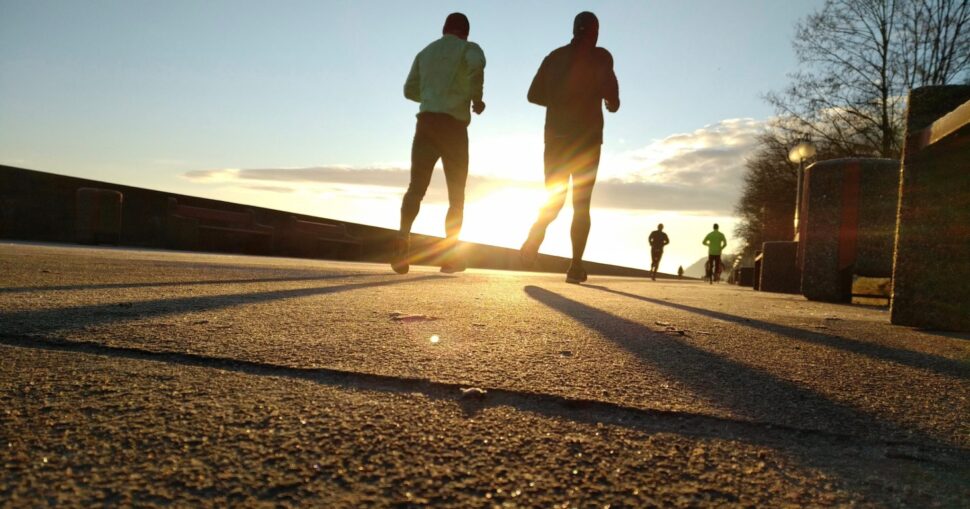
Specified Complexity Is All Around Us
Recovery Beyond Featured In

BY: Sarah Chaffee
If you fail to plan, you plan to fail. That’s something a CPA told me the other night.
Achievement is not random. It requires intelligent design. A key idea in the theory of ID is specification, or matching a pattern. Specified, complex information is a hallmark of intelligent activity. Humans can envision an end goal. Chance and determinism fail to produce specified complexity, but the mind can create it. ID theorists including William Dembski have given mathematical rigor to this idea. But it’s all around us in everyday life.
I find the power of intention hard to overstate. Bear with me as I examine a few illustrations.
Intention in Finances
Have you heard of Dave Ramsey? He is the get-out-of-debt guru, with seven “baby steps” to fix your debt situation, from creating an emergency fund to putting away retirement savings. People across the country follow his methods and credit him with getting them onto solid financial ground. There’s a plan, and there’s execution.
Some counselors offer advice that goes more heavily into the details. The FIRE (Financial Independence, Retire Early) movement began recently but is growing. One group, ChooseFI, lists its own “Pillars of FI,” from low-cost index fund investing to tax optimization and hacking student debt. Randomness and determinism are the enemies when it comes to financial success — planning and information are one’s greatest assets.
Intention in Health
Here are a few facts for you. The American Heart Association recommends 150 minutes of moderate intensity exercise per week, just to keep your heart working well. From various studies, it seems that the Mediterranean diet (yay for wild caught fish!) may be one of the best ways to eat. Clearly, intelligent design, which means planning and execution, not going with the flow, is key to health and fitness.
How about athletics? Running, in general, seems hard at first, but people can work up to a half marathon in a few weeks by starting quite small and working consistently according to a plan. I love programs like Recovery Beyond Paradigm or Team Mission here in the Puget Sound — RBP helps those dealing with addiction to get and stay clean through hiking and mountaineering (spoiler: they climb Rainier or Adams), and Team Mission does the same — with running.
Intention in Learning
During college, my foreign language was Mandarin Chinese. I enjoyed spending two summers in China, practicing and improving my language skills and volunteering with an NGO. But there are people who go much further. For them, language learning becomes a passion. Polyglots learn multiple languages. I heard an interview with one polyglot who learns a new language every two years. Polyglots are very intentional in their process, not relying on the guidance of a teacher, but fine-tuning their methods for learning grammar, pronunciation, and more.
How about the music? The other day I found myself at a concert where a junior in college played four stunning pieces on the harp, all from memory. Afterward, his teacher mentioned to me that it was easy to teach him because he could learn almost any piece of music she put in front of him. The intricacies of learning the music and then memorizing it are just baffling. It doesn’t come by following the flow where it leads you. Again — musicians and language learners eschew chance in favor of discipline and specific goals.
Planning and follow-through bring excitement and hope. Some part of us knows that mind must triumph over matter and circumstance if complex order is to prevail. Neo-Darwinian evolution, which depends on chance and determinism, does not fit with this perspective, nor with our experiences.
Photo credit: Tomasz Woźniak via Unsplash.
-
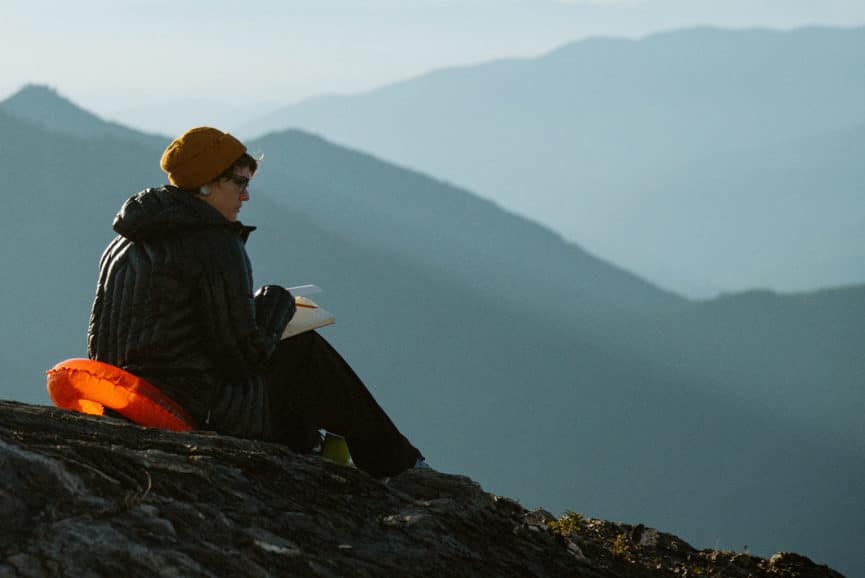
Discover Abi’s Climb
Anyone who grows up in the Seattle area is used to seeing the large visage of Mt. Rainier on the skyline (when weather permits, that is). Most of us glance at it with some sort of awe – but some of us have stronger feelings. “I see the mountain all the time and joke that I’m mad at it,” says Abi Brewer. Abi has made two attempts to climb the 14,000-foot peak; both were turned around due to unsafe conditions. But this spring she’s preparing for her third attempt, this time as a fundraiser for Recovery Beyond, the program that changed her life and started her mountaineering journey.
As recently as two and a half years ago, if you’d asked Abi about her mountain aspirations and accomplishments, the list would have been short. Although she grew up in the Seattle area, she had never been much of a hiker. A long-standing battle with alcoholism resulted in her losing her family and brought her to New Life in Tacoma, where she stumbled onto the Recovery Beyond climb team. It wasn’t exactly love at first sight. “I hated it at first,” she said, “Everything was just so hard. I didn’t even like the hikes.” In the long run, however, some of the most miserable parts of her journey ended up being turning points. That year, their summit attempt of Mt. Hood was one of the most excruciating, throwing inclement weather and severe cold at a group of newbie hikers. “I have honestly never been so miserable in my life,” she says, “But I survived. That was what was empowering. I felt like such a badass just for having survived that discomfort.” That year she also bagged her first “big” peak, Mt. Baker, in similarly lackluster conditions: it was rainy, cold, and white-out conditions occluded all view. “I just cried. Like, how did I get here? It was not how I imagined my life would look.”
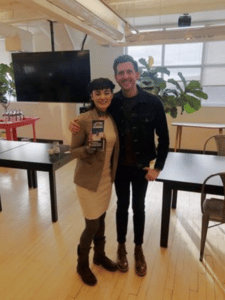
Abi with her brother at a recent event.
Now two years and three months sober and a New Life graduate, Abi continues to use the lessons she learned in the program in her day-to-day life. Exercise has become a mainstay of her anxiety-management protocol, as has the community she found at New Life. “Honestly, having that community is like, you need it in recovery. I wouldn’t have learned the importance of it without the New Life program and the Climb Team.” She and her husband are also in the midst of opening a tattoo parlor called “Northern Sanctuary Tattoo,” a risk she doesn’t feel she would have taken without having been through the program. “We see this company as a way to minister to people who might not have as much exposure to Christianity,” she says.
Abi also maintains her commitment to helping others achieve this same kind of transformation. “You get into rehab and you feel like you have nothing going for you. I just want to support people so they can get out and tell their story.” Besides volunteering at New Life both in the climb team and by leading Bible studies, she has also chosen to join the fundraising climb of Mount Rainier. A team of 8 climbers, guided by IMG, is making a summit attempt on Mt. Rainier May 16-19 this year in honor of the Recovery Beyond program. Each climber’s donations will support two individuals in the Climbing Out program. For Abi, this cause is deeply personal. “Without the climb program, I wouldn’t feel as complete. It really made my quality of life as a sober person – I’m happy.”
So what better way to exact “revenge” on the mountain that has eluded her than to climb it in honor of a program that has meant so much to her? “I’m just hoping the third time’s a charm,” she jokes.
Want to help Abi meet her goal? Check out her fundraising page below or join her on Sunday, February 24 at Northern Sanctuary Tatoo (her new studio) for a fundraising night featuring a screening of the film “A New High” as well as art by local artists and tattoos by donation. If you’d like to snag one of the last spots on the climb, details can be found on the Fundraising Climb page.
DONATE TO ABI’S CAMPAIGN
Archive for 2019
Recovery Beyond > 2019
